
Are there homeopathic remedies that can help hay fever sufferers? Indeed there are. If you follow this blog you will know that Classical Homeopathy follows the ‘law of similars’. Simply put this means that the characteristics of the ailment as experienced by the patient must match the ‘picture’ of the homeopathic medicine / remedy.
Several homeopathic remedies have that hay fever ‘picture’. Of course that ‘picture’ varies from individual to individual. For some it is sore and red eyes, for others sneezing and so on. So the challenge is to match the remedy to the case.
Continuing with the series on remedies in a typical home first aid kit, in this blog I focus on kit remedies that have a particular affinity to hay fever. For more on the benefits of purchasing a first aid kit of basic homeopathic remedies see my earlier blog Family Care with Homeopathy
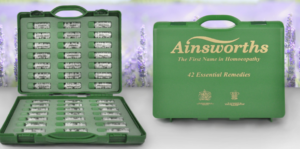
Classical homeopathic prescribing for acute complaints considers the following:
Consider homeopathic treatment like finding the right key for a lock, if after a taking the remedy for a short while (say one pill every 4 hours for a day or two) there is no response, then try another. Note also that homeopathic medicines are absorbed through the mucous membranes of the mouth – not the gut – so you let the tablet or pill dissolve under the tongue.
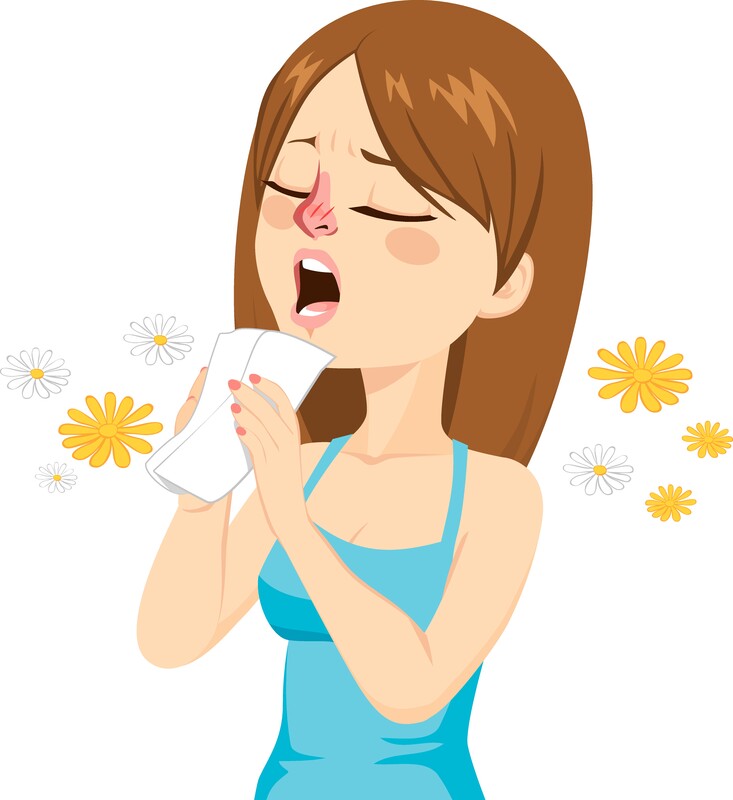
Hayfever is an acute allergic reaction to certain types of pollen. A type of allergic rhinitis where grass tree and flower pollens and / or mould spores cause the body to over react. Histamine is produced which draws fluid to the site of the irritation causing the familiar symptoms of redness, itching, swelling. The eyes and nose are most affected but the upper respiratory system can all be irritated.
Over the counter conventional treatments are mostly of the anti-histamine type. These used to risk drowsiness but this effect is less with newer formulations. Sometimes steroid containing nasal sprays are prescribed to reduce inflammation of the nasal passages. On the NHS website there is a useful overview with an accompanying short video from and ENT Consultant.
From a Homeopathic point of view there are a number of common remedies available in typical first aid kits sold by such as Ainsworths (see above) and Helios. However, deeper constitutional treatment is recommended where the hay fever symptoms cause discomfort year on year.
The herbal products from Vogel have been around a long time, and may also help.
The annual recurrence of hay fever symptoms, which can be quite debilitating, indicates a genetic predisposition. For example hayfever sufferers may be aware of a familial history of respiratory condition such as asthma. By strengthening the consitution – in effect addressing underlying factors – the allergic response is reduced. Homeopathy has long recognised familial traits and endeavours to address these.
Addressing these underlying traits is not as easy at taking an over the counter remedy from the pharmacy. It may take two or three seasons to yield long lasting benefits. But the goal is long lasting benefit and not just symptom management.
That said the homeopathic approach has a good track record and if you would like to discuss this further please do book a free Discovery Call
For short term symptomatic relief here below are some remedies typically found in first aid kits that you can try.
Allium Cepa is a homeopathic preparation of the onion plant. The common reaction to chopping an onion points to the characteristics of this remedy. Burning discharge from the nose and bland discharge from the eyes. Strangely being indoors makes the symptoms worse.
Here the picture of Allium is reversed, with the burning discharge from the eyes, which are swollen with bland discharge from the nose. The sufferer may cough and bring up phlegm.
Indeed this is a remedy from Arsenic, but remeber that homeopathic remedies are potentised ultra dilutions so there is no risk of poisoning! The picture here is of restlessness, a thirst for hot drinks taken at short intervals. The discharge is bland. There is sneezing and tightness in the chest. Where the picture fits, this is often a remedy for the common cold. Where there is chronic nasal catarrh with a thick yellow discharge think of the related remedy Arsenicum Iodatum.
Here there is much sneezing and the patient feels quite apathetic and quite drowsy with heavy eyes. This is also a remedy well associated with the ‘flu like state – dull droopy and drowsy.
Eyes smarting, and sensitive to light, with a stuffy nose and obstructed breathing. Itching in the ears and eustation tubes. General irritability.
This is a combination remedy. A preparation of pollens from many sourced prepared in the usual manner for homeopathic remedies. It is often a useful catch all.
Something similar is Dr Reckeweg R84
These are just a few of a long list of homeopathic remedies that are known to help with hay fever symptoms. To get a deeper understanding of your case an in-depth consultation is suggested and if you would care to discuss this further please book a free 30 minute discovery call from my website.
Some time back, I wrote a short blog on the topic of Homeopathy and Christianity. It seemed to generate some interest and I return to the topic.
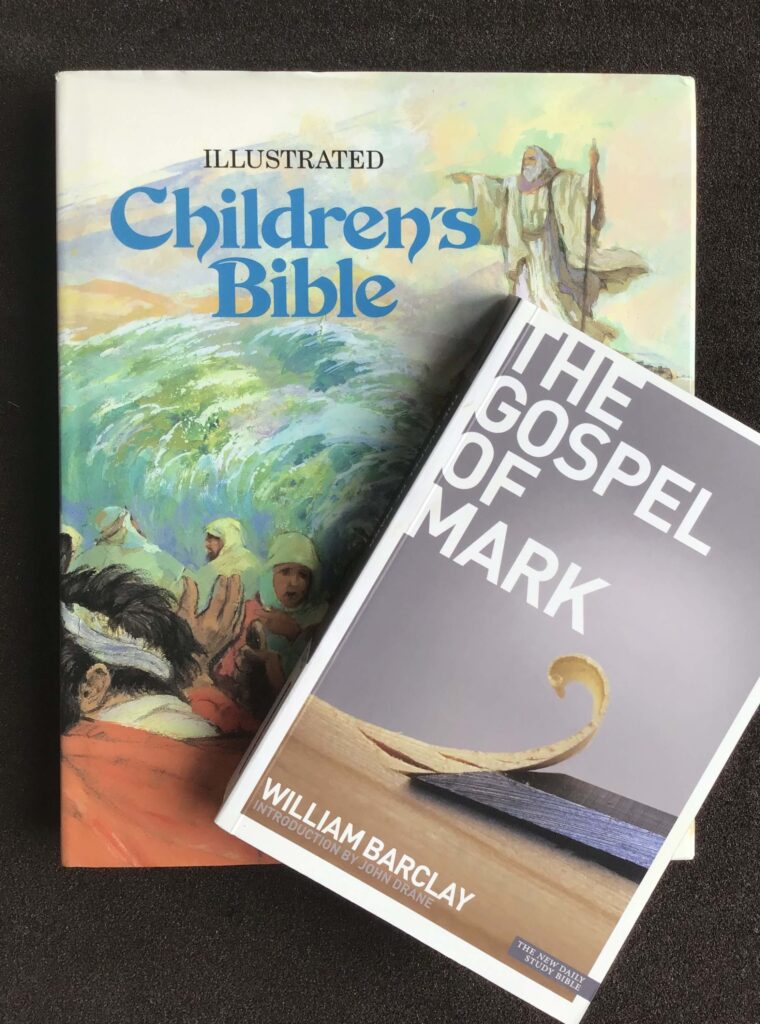
In a journal I edit, a retired GP reminisced about his career as a GP in Surrey. The wonderfully initialed Dr R.A.F. Jack introduced him to Homeopathic Medicine at the Royal London Homeopathic Hospital.
He wrote, ‘A surprise that hurt came when the head of a large family that had benefitted from homeopathic prescribing courteously requested that I should no longer prescribe that sort of medicine. The gentleman had attended a Christian Alpha Course where he learned that homeopathy was “the work of the devil” and he wanted nothing more to do with it’.
Curious, because the obituary for the aforementioned Dr Jack says that his local Evangelical Church minister introduced him to Homeopathy.
The Rector of my local Anglican Church, assured me that the Alpha Course does not mention Homeopathy. He invited me to attend, and duly ‘hoisted with my own petard’ I went along!
For those unfamiliar with the Alpha Course, it is simply an introduction to Christianity. It runs over several weeks allowing free discussion and sharing of views. The course originated at Holy Trinity Brompton (known for short as HTB) has been very successful over the years. The accompanying videos are fronted by priest Nicky Gumbel, a former barrister from a lineage of barristers. Thus, one is assured of a gifted communicator (which he is).
The evenings were sociable, proceeding as expected. There were few surprises (writing as a Church attender of long standing) and indeed no mention of Homeopathy.
Christian Healing was the topic one evening: through prayer or the laying on of hands. What surprised me here was the expressed exclusivity; that Christian Healing stands apart from other forms of similar intervention. So, for example Christian laying on of hands is appropriate, but Reiki (a similar process) is not.
Some argue that if it is not ‘Christian’ there is risk of attracting negative energies. It is not difficult to reach a ‘work of the Devil’ viewpoint, if you follow this line. The energetic (see below) nature of homeopathic medicines doubtless adds to the angst.
As the Japanese words Rei (universal)-ki (life energy) show, healing energies are – and surely must be – universal. The universality of ‘healing’ is also apparent in a landmark study initiated by Sandy Edwards of the Healing Trust. I suggest the keyword in healing is ‘intent’ (or love) and not orientation to any particular creed.
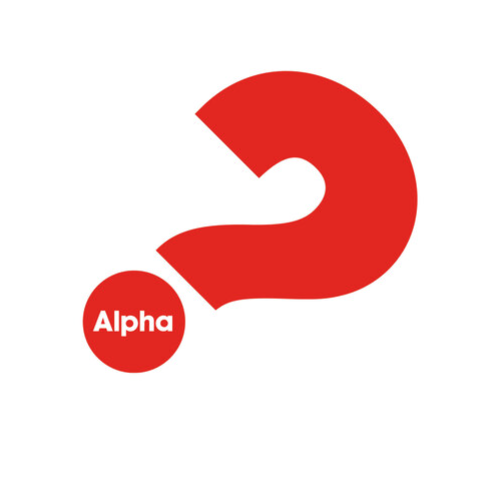
So does the ‘work of the Devil’ argument make sense?
Perhaps the non-material (aka energetic or spiritual) concept troubles you? If, so then consider that all around you are the waves and signals of this Information age. Ne’er a molecule to be seen. A software download to the body is a good analogy for a homeopathic medicine, the active component of which is non-material. It informs, nonetheless.
This is the world of physics rather than chemistry; the world of Energy Medicine.
Energy Medicine is a general term for therapies that aim to maximise the innate healing potential by rebalancing ‘energy’ flows in the body. This contrasts much of orthodox medicine which is predominantly concerned with symptom management often requiring long term medication.
If you have a moment, look at the website of the Christian Medical Fellowship and search on the word ‘Homeopathy’.
An article (as of 8/25 no longer accessible) by retired GP George Smith is one that caught my eye. His concluding summary is as follows:
‘It is appreciated that there are committed and zealous Christians – including past and present doctors, nurses and missionaries – who have found homeopathy acceptable and useful in their ministry. In today’s climate of integrative medicine, it is particularly relevant for Christian doctors and nurses to decide whether or not they find homeopathy acceptable. Scientific evidence, biblical guidance and discernment from the Holy Spirit all play a part in making this decision. Having said this and taking into account everything discussed in this article, it is my own conviction that homeopathy clearly falls far short of being a therapy that can be acceptable to use or recommend.‘
‘Prove all things, hold fast to that which is good, abstain from all appearance of evil.
(1 Thessalonians 5:21-22, King James Version)’
One might ask what The Bible has to say about 21st century medicine FULL STOP, orthodox or complementary or alternative? Surely the answer is absolutely nothing!
The works of physicians like Galen (129-216AD) give some insights into the practices of the time. Dr Malcolm Kendrick touches on the subject in this amusing blog from August 2022.
I made a quick skim of the synoptic Gospels of Matthew, Mark and Luke. The healings of Jesus or Nazareth, divide between those healed through faith or belief, and the exorcism of demons. Neither are explicable rationally in terms of current medical knowledge (which is rather the point).
Did the withered hand, the leprosy or the possessed heal instantly? We cannot know, but this is the inference, hence they are miraculous events.
With tongue firmly in cheek, I observe that Jesus never once wrote a prescription saying ‘take thee to the pharmacy’!
Jesus asks us to consider our spiritual nature. He tells us who we are (made the image of God) and what our conduct should be towards our fellow man. There is plenty here for the CMF to consider.
Though our NHS and the medical treatments offered have much to commend them, the story is not always rosy. The human body is hugely complex. Despite the advances of the 20th century, there is much we do not understand. Technology brings new insights but sometimes at the cost of lost past wisdom.
Dr Smith, appears to present a balanced argument. But instead reflects the dominant reductionist bio-chemical model and the ‘skeptic’ platform. He is entitled to his view. But this has no relevance to the Biblical message.
Finally, a concluding aside. It puzzles me that Doctor Homeopaths – Members of the Faculty of Homeopathy – are rarely consulted when an assessment of Homeopathy is required. I suspect that some will be members of the CMF. One would think that commentary on any other speciality in medicine would come from one knowledgeable in that speciality!
Don’t you?
Thank you for reading. Next time I will return to considering first aid remedies in homeopathy – probably on the topic of hayfever – well, there is an upside to all this rain.
Do book a free Discovery Call if you wish to explore if Homeopathy can help you.
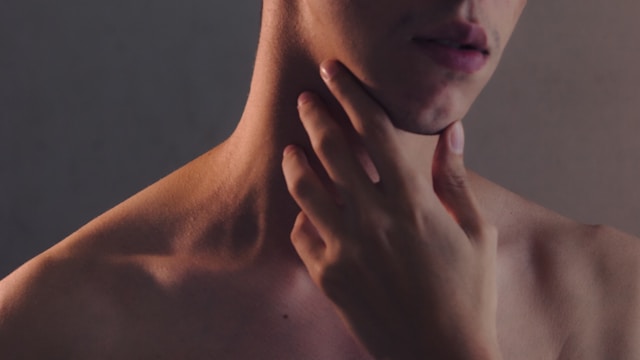
Are there homeopathic remedies for a sore throat? Indeed there are. If you follow this blog you will know that Classical Homeopathy follows the ‘law of similars’. Simply put this means that the characteristics of the ailment as experienced by the patient must match the ‘picture’ of the remedy (homeopathic medicine).
Many homeopathic remedies have a sore throat ‘picture’. Fortunately, there is overlap between the various remedies such that absolute precision is not required.
Continuing with the series on remedies in a typical home first aid kit, in this blog I focus on kit remedies that have a particular affinity to sore throats. For more on the benefits of purchasing a first aid kit of basic homeopathic remedies see my earlier blog Family Care with Homeopathy

Classical homeopathic prescribing for acute complaints considers the following:
A sore throat is a blanket term for inflammation or infection affecting the tissues of the throat. Typically affecting the tonsils and adenoids. These specialised tissues are part of the immune system which guard the airway (Pharnyx). Sometimes there is a loss of voice if the infection spreads to vocal box/chords (Larynx) located below the Pharnyx. The diagnosis reflects the location, hence Tonsilitis, Pharyngitis, and Laryngitis.
The offending microbe is often a virus, but it can be a bacterium (hence “Strep” throat).
Wikipedia gives a good overview on the orthodox treatment of tonsilitis.
The typical symptons of pain on swallowing, swollen tonsils, a dry throat and possibly fever are doubtless familiar. The formation of an abcess behind a tonsil is known as Quinsy and is particulary unpleasant and may make jaw movement painful.
Most sore throats self-resolve in a week or so. A course of antibiotics is the orthodox treatment (where the cause is bacterial) and should always be considered in urgent cases. If there is severe pain with significant difficulty swallowing or difficulty breathing NHS guidance is to go to A&E.
However, a well selected homeopathic medicine can usually reduce the duration of any infection.
By the way, it is perfectly possible and appropriate to take homeopathic medicines alongside orthodox treatment. Homeopathic medicines function in a different way to antibiotics or analgesics (pain killers). There is no conflict and in this context they are indeed complementary.
Homeopathic medicines are neither antibiotic or antiviral in the conventional sense. Rather they stimulate the immune system of the body to overcome the infection.
We need to be midful of antibiotic resistance and use our antibiotics appropriately.
If you suffer from recurring throat infections, this is probably a sign that your body is struggling to restore and maintain good health. Professional homeopathic care can assist your body’s own defences, increasing resilience and breaking the cycle of repeated infections. In homeopathy we call this Constitutional Treatment.
If you want to discuss this further, you can book a free 30 minute discovery call with me here.
Described below are ten of the homeopathic remedies useful in sore throats which you will find in most homeopathic first aid kits. The one which will engage your body’s healing process is the one which most closely matches your specific symptoms.
Consider every homeopathic medicine a ‘key’. If it fits the ‘lock’ you will get some improvement in a couple of hours. Falling asleep is a good sign of healing taking place.
If there is no improvement, there is no harm whatsoever in trying another remedy. As sore throats share characteristics, matching the general characteristics of the remedy may best aid selection.
The first three (Aconite, Belladonna and Apis) I have written about before in more general terms.
These two remedies are similar – yet different. Both can have an associated with high fever.
Aconite is often the remedy to give in the early stages of infection when the onset of symptoms is sudden. A typical cause if becoming chilled when hot.
The general characteristics of Aconite are fear, restlessness and anxiety.
The onset of symptoms is sudden; within just a few hours of exposure to the cause. The throat, it is dry, very red and constricted. Cold drinks bring some relief. There is an initial affinity for the left side (e.g. left tonsil).
The general characteristics of Belladonna are heat, redness, throbbing and burning. In a word violence. Children have high vitality which means that their immune systems respond accordingly (i.e. violently!). Belladonna is a ‘must have’ children’s remedy.
The onset of symptoms is somewhat slower than that for Aconite. Though hot, the patient feels chilly and wants to be covered (‘Aconite’ prefers the cool air).
There is anger / irritability and the affinity is for the right side (contrasting Aconite). The patient is not so thirsty but may take small sips of water (lemon flavour appeals) to ease the dry throat and the continual desire to swallow.
Apis is a homeopathic medicine made from the venom of the bee.
The general characteristics of Apis match with the effects of a bee sting: burning-stinging pain and swelling.
This is a medicine for highly inflamed and swollen tonsils, perhaps with ulceration. Swallowing is difficult. Patients are not especially thirsty but sucking ice cubes may help. This patient is restless (think ‘busy bee’).
p.s. It is also a useful medicine in urinary tract infections (along with Cantharis)
The general characteristics of Bryonia are dyness (‘DRY-BRY’), great thirst, worse for movement and better for rest. The Bryonia patient can be irritable.
The onset of illness in the Bryonia patient is slower. Perhaps 24 or 48 hours after exposure to the cause, which may be damp or autumn weather (hot days / cold nights).
This slower onset reflects the lower vitality of the patient. Where the Belladonna picture often matches the child, Bryonia is more suited to the adult. Soon there is much catarrh. Compared to Aconite, Belladonna and Apis the throat has a duller hue.
The general characteristics of Gelsemium are dizziness, drowsiness and dullness. A state of apathy and weakness (‘Worn-out’).
These characteristics often match the influenza picture. Again the onset is slower. The tonsils are red and swallowing is difficult due to muscular weakness. There is itching in the palate and nose and a sense of a lump in the throat. The voice may be weak either from the nervous state or catarrh.
(p.s. My son at about age 4 – now 34! – responded almost instantly to this remedy. I had previously tried Belladonna to nil effect and was on the cusp of calling the doctor.)
The general characteristics of Hepar Sulphuris are suppuration and hyper-sensitivity (cannot bear the affected part to be touched). This is reflected in the impulsive mental state (‘touchy’).
This is a remedy where the tonsils and glands are swollen, possibly with pus and the throat feels constricted. There is a very typical sharp, stitching, splinter-like pain in the throat (described as a stuck fishbone or like swallowing broken glass), which often affects the ears when swallowing. The throat is sensitive to touch and cold. The symptoms are relieved by hot drinks.
The general characteristics of Lachesis (from a snake venom) are loquacity (talks constantly), suspicion and again great sensitivity to touch. The collar must be very loose.
This is a remedy for Quinsy with ulcerated tonsils. The throat of the Lachesis patient is dry and has a purplish colour. The onset of symptoms is on the left side and the pain extends up into the ear. There is an inability to swallow and a curious feature that liquids cause more difficulty in swallowing than solids. Another curiosity is that symptoms tend to worsen after sleep.
The general characteristics of Merc.sol. (as typically abbreviated) are seen in the metal of the same name; the only metal that is liquid at room temperature. It reacts to temperature (mercury thermometer) and is generally unstable (trembling).
This is another remedy for Quinsy. The sore throat requiring this medicine is putrid, swollen bluish-red, perhaps with ulceration and pus. Despite the pain, saliva must be swallowed. There is a metallic taste in the mouth. Much perspiration is another feature.
The general characteristics of Lycopodium are careful, cautious, conscientious. There is apprehension with a certain lack of confidence, and a tendency to digestive troubles and flatulence.
Lycopodium throats tend to begin on the right side with swelling, suppuration and ulceration (which can affect the voice). There may be sensation of a ball in the throat. The patient is better for warm drinks.
The general characteristics of Silica are a yielding nature, with weakness and poor assimilation of nutrients. Ulceration with poor healing may result. There is great sensitivity, anxiety and touchiness.
This is a remedy for a severe type of tonsilitis where swallowing is very difficut, causing a cough. Abcesses may form yet not suppurate, ot not heal. There is a left sided affinity. The patient is chilly but desires cold food. It is a remedy that is complementary to Hepar. sulph and Merc.sol and may follow these medicines where the symptoms have not fully resolved.
****
If you regularly suffer from sore throats (or have one now that is not resolving) and wish to see if homeopathy can assist, please contact me here
This short article considers first aid with ‘Belladonna’ a homeopathic remedy for fever (and more). This is a remedy commonly found in homeopathic first aid kits available from pharmacies such as Ainsworths and Helios
Please read my initial article in this series, if you have not already done so
The homeopathic remedy Belladonna originates from the plant of the same name. Its common name is ‘deadly nightshade’. Poisonous plants often make the best medicine!
The plant contains the alkaloid atropine, a form of which is used to dilate the pupils in an eye examination. Italian ladies used the plant for the same reason, thus enhancing their allure, and so we have Bella Donna (beautiful woman).
Prepared homeopathically it is another fever remedy. It is similar, yet different, to Aconite – which I covered in an earlier blog.
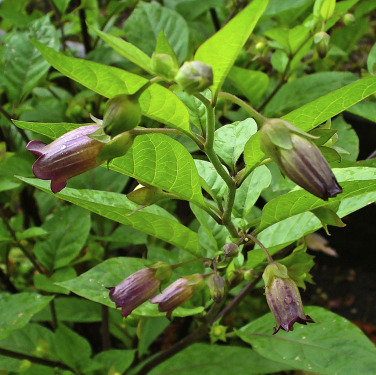
Classical homeopathy prescribing follows the natural law of similars. This means that you select the remedy by matching its picture to the symptoms of the patient.
Every homeopathic remedy has both mental / emotional and physical characteristics. The patient will not exhibit every characteristic of the remedy. Just capture the general theme.
Try to establish three out of the following four:
Belladonna is a great homeopathic remedy for fever in children. The Belladonna state requires the strong vitality that is characteristic of young children. At the other end of the age range, the Belladonna state is rare to find. Indeed the elderly may not have the vitality to throw a fever, if they have it is a good sign.
Remember that the body fights infection through fever (raising the temperature of the body). Except in extreme circumstances a fever should not be suppressed. Current NHS guidance recognises this.
For the late Dr RAF Jack, Aconite was his No1 recommendation for fever, and Belladonna ranked No2. Dr Jack (see below) was a GP who used homeopathy extensively in his Bromsgrove practice in the 1950s to the 80s. He provided all his patients had a basic kit of homeopathic remedies (available on the NHS then).

And both these remedies are prefereable to paracetamol albeit requiring a little more knowledge in their use.
Where the Aconite patient has anguish and restlessness, Belladonna in contrast has rage! The onset is slightly slower than that of the Aconite type of fever.
A pill can be dissolved in the mouth (typically 30c potency). Better is to dissolve a pill in a little water and give a teaspoon to the patient. A few doses at 15 or 30 minute interval should suffice – reduce the frequency or stop once there is improvement – the body will do the rest!
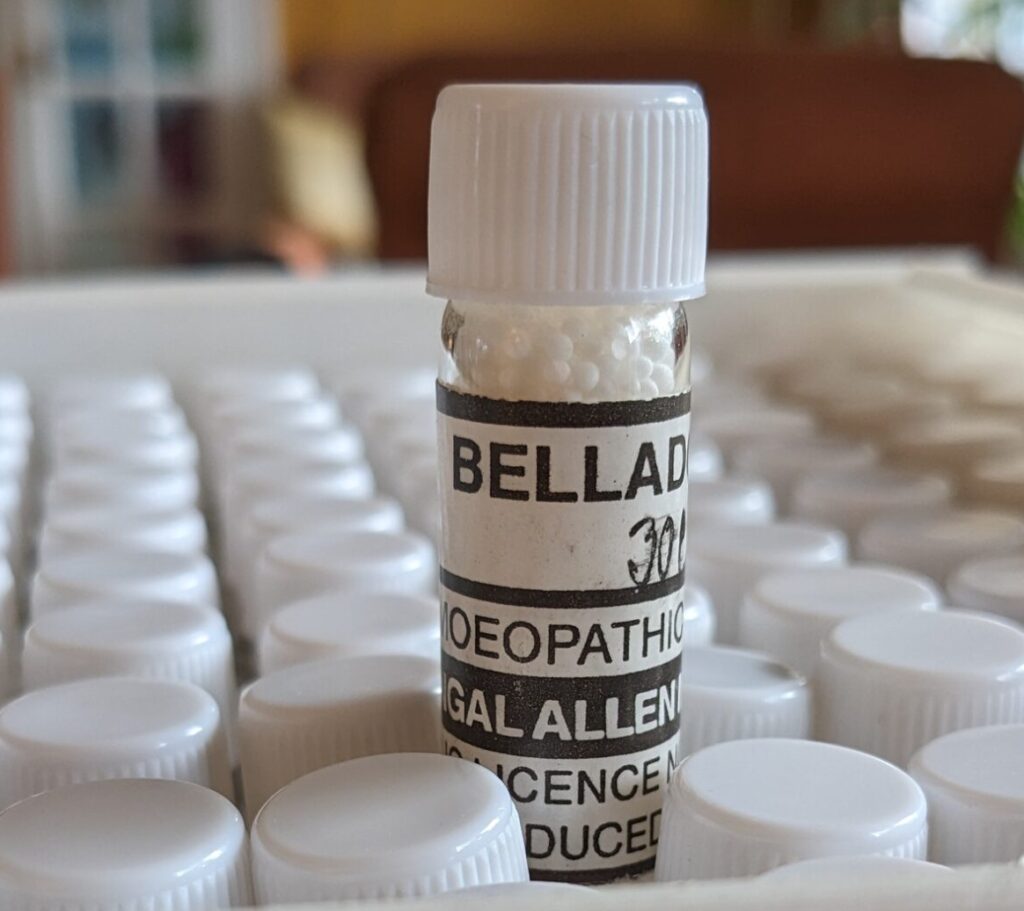
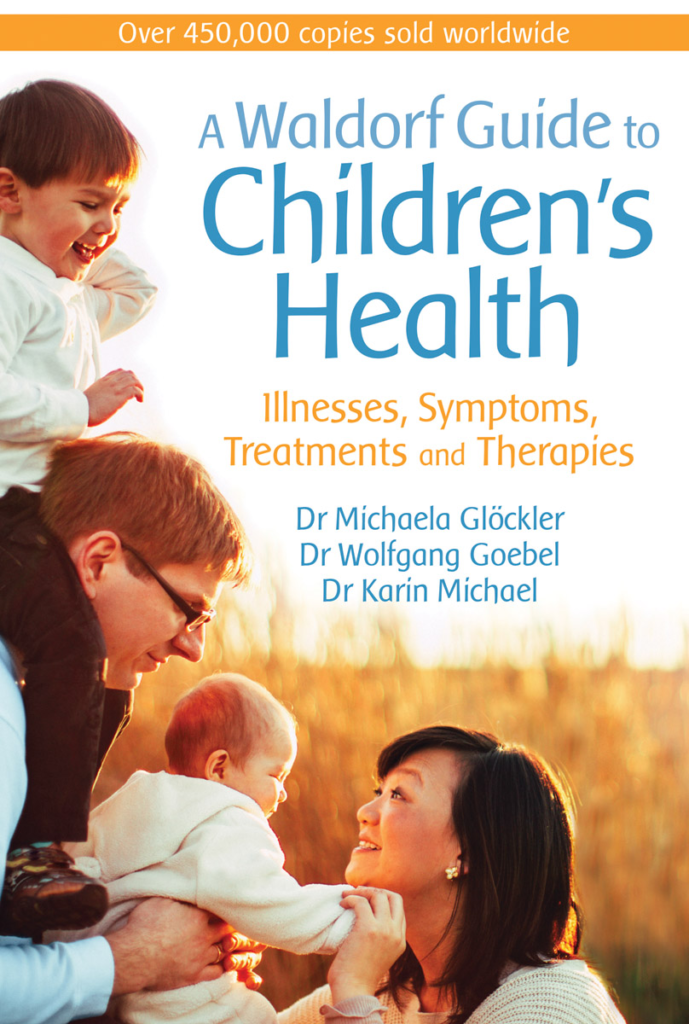
This Waldorf Guide is a useful purchase. The authors give some guidance on fever in children. They say that a restless child may refuse to stay covered so need the calming presence of an adult who will tell stories etc. The child should have light clothing and bedding. Fresh air but no draughts. Give plenty of fluids (diluted fruit juice). Bland diet – but only if the child is hungry. Elsewhere, the guidance was as above plus no TV or computers – radio is ok. And most important – rest! The Waldorf guide uses Anthrosophical remedies which are similar to homeopathics – again Belladonna but also a Belladonna / Apis combination.
The genus name for the honeybee is Apis Mellifera. Apis is a useful homeopathic remedy and this blog is the next in the series of first aid remedies for the family. The origin of this remedy is the venon of the honeybee. As we will see the guiding symptoms will be familiar to anyone who has been stung by a bee, and indeed reflect the characteristics of the bee in common speech – busy as a bee, queen bee and so on.
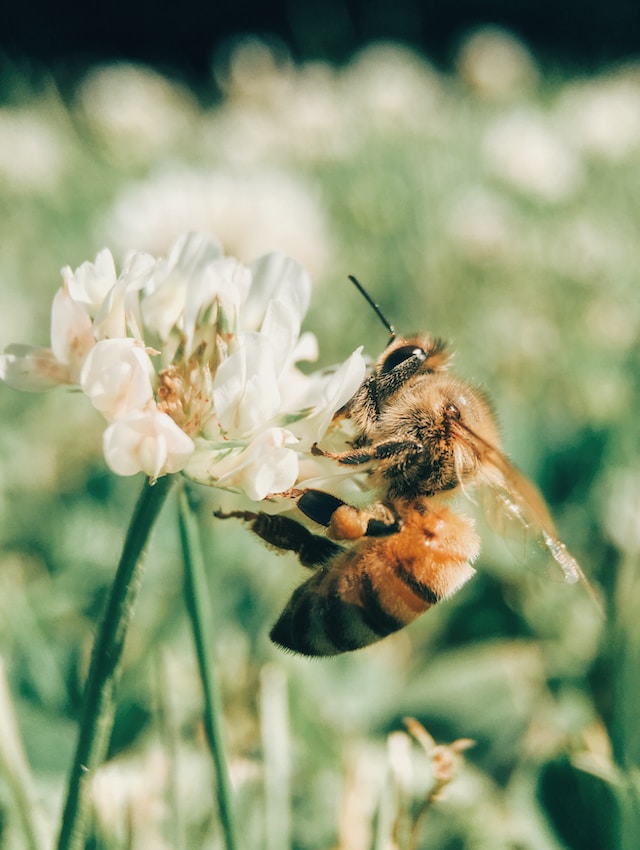
Classical homeopathy prescribing follows the natural law of similars.
This means that you select the remedy by matching its picture to the symptoms of the patient.
Every homeopathic remedy has both mental / emotional and physical characteristics.
The patient will not exhibit every characteristic of the remedy. Just capture the general theme.
Try to establish three out of the following four:
This is a remedy for any condition where the classic features of the bee sting are seen. The key symptoms are burning, stinging, redness and swelling. So it is a remedy for bee and other stings (but think also of Ledum). Swellings can occur anywhere, skin, mouth and throat, around the eyes, neck or abdomen. Think of apis when there is an allergic reaction, urinary infection (cystitis) with burning (also consider Cantharis ), tonsilitis and so forth. There may be numbness or paralysis of the affected part.
Where the general picture fits, this remedy can help with more demanding complaints such as shingles (burning pains), kidney disease (leading to oedema), ovarian pain (burning), and asthma (cannot get another breath)
Local marketing consultants Honeybee capture some of the mental characteristics of bees on their website. Busy bees indeed…

I wrote about the Allium Cepa (the onion) Homeopathy back in 2021 from a slightly different angle. Here, as part of an ongoing series, I consider the remedy from a first aid perspective. The origin of the remedy is of course the common oinion. I am sure that you have chopped up some onions and so you know the effect.
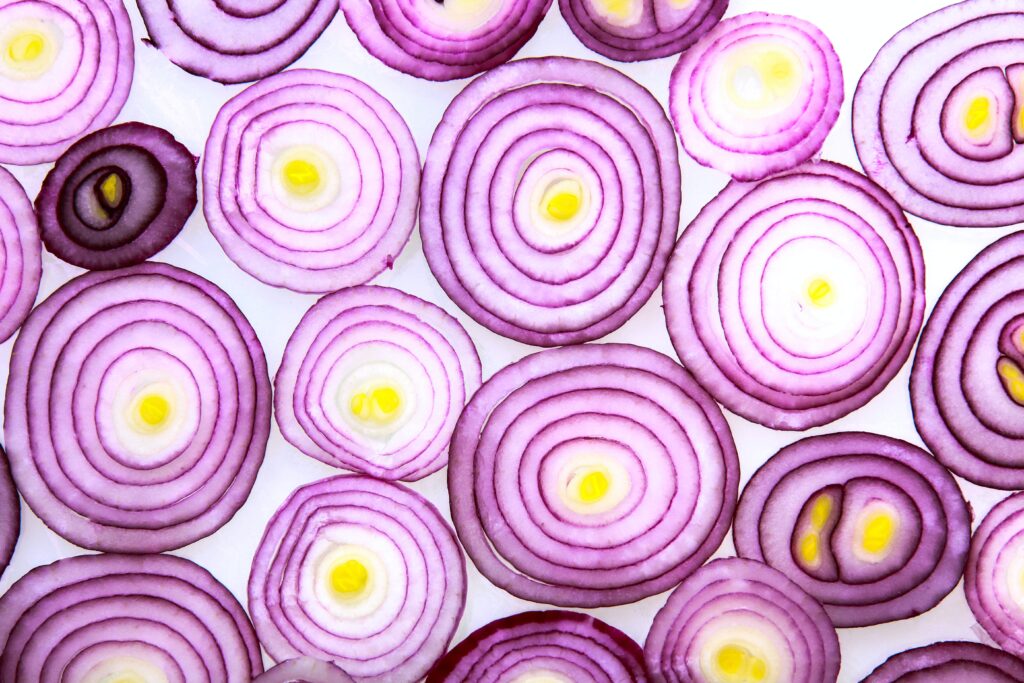
Classical homeopathy prescribing follows the natural law of similars.
This means that you select the remedy by matching its picture to the symptoms of the patient.
Every homeopathic remedy has both mental / emotional and physical characteristics.
The patient will not exhibit every characteristic of the remedy. Just capture the general theme.
Try to establish three out of the following four:
This remedy is of plant origin. It is, as I have said, the common onion.
This is a remedy for upper respiratory tract infections or allergies which primarily affect the eyes and nose, but can extend into the ears and throat. It is also a remedy of value in seasonal hay fever (Roger Morrison MD – Doctor / Homeopath in the USA – says it cures up to 30% of cases for a season, but permanent cure requires deeper acting remedies)
The patient may desire onions and – curiously – be averse to cucumber
Injudicious use of this remedy to suppress an inconvenient runny nose in the common cold risks driving the infection deeper (remember discharge is an aspect of the attempt of the body to cure). So use this remedy when the symptoms are more severe
Can homeopathy help with a cough? Yes it can. If you follow this blog you will know that Classical Homeopathy follows the ‘law of similars’. Simply put this means that the characteristics of the ailment and the remedy must match.

Unfortunately many homeopathic remedies have a cough ‘picture’. Fortunately, however, there is considerable overlap between the various remedies such that absolute precision is not required.
Coughs that fail to resolve warrant further investigation by your GP.
***
Continuing with the series on remedies in a typical home first aid kit, in this blog I am going to focus on kit remedies that have a particular affinity to coughs.

Classical homeopathic prescribing for acute complaints considers the following:
Put another way, items 2,4,5 on this list are your main symptoms.
So let’s have a look.
This is a dry cough. The characteristic of this remedy is sudden onset. There may be fever or chilliness with shivering. The symptoms are worse around midnight. The cough is hoarse and dry. The patient is thirsty. This is a remedy for the first 24 hours only. If the cough continues then change to another of the remedies below.
This is a wet cough. Breathing is difficult because of the phlegm (which is white) and so there is rattling in the chest. Worse in warm stuffy rooms and at night. Better sitting up. A remedy for the very young and elderly. Thirsty for cold drinks
This is a dry asthmatic type of cough with wheezing. There may be a sense of constriction, tightness and / or burning though you may feel chilly (so better in the warmth). There is great restlessness. The symptoms are worse around midnight. Warm drinks help and taken regularly is small sips (rather an Arsenicum keynote)
This is a dry, hard cough. The onset is slow (not like Aconite). Because everything is sore you do not want to move – this is a key characteristic. You are irritable and want to be left alone. Generally better for pressure and long drinks (very thirsty).
This is a dry cough that comes in spasms – you can hardly catch your breath. Consequently the stomach muscles may be painful. The cough is worse when lying down making sleep difficult. Better for slow movement in the open air.
This is a wet cough with thick yellow mucus (infection) – often dry at night and loose in the morning. But it is also useful in croup which has a dry cough. You will be chilly and want to be wrapped up. Worse at night in bed.
Totally dry cough – tickling and comes in paroxysms with choking or gagging, with wretching / vomiting. Worse in the evening and in a warm room and better with warm drinks. The nose may bleed.
Dry teasing cough with soreness in chest. Throat raw. Spasmodic with wretching. Feverish – colds go to chest. Irritable and impatient. Better with warmth. Better in the evening but then worse after midnight.
Violent dry cough with irritation in throat, but lungs congested. Laryngitis. Seeks comfort and sympathy. Nervous temperament. Cold drinks may be vomited.
Changeable cough – loose in the morning, dry during the day and then loose in the evening. Thick yellow mucous. Craves attention and sympathy. Better in open air.
Bronchial catarrh with wheezing. Sound like a saw going through board. Alternate with Hepar Sulph in Croup.
India is perhaps the most notable country for the wide practice of Homeopathy. There are pathways for medical students to study both western medicine and homeopathy as well as other traditional forms such as Ayurvedic medicine.
Dr Saptarshi Banerjea in Calcutta (Kolkata) recently posted a video on the subject of coughs and remedy selection. Quite entertaining (unless you have the cough in question!)
Not everyone has the skills of Dr Banerjea, but nonetheless, homeopathy can help shorten the duration of any cough resulting from respiratory infection.
This short article considers first aid with homeopathic ‘Aconite Napellus’, usually just known as the remedy ‘Aconite’. This is a remedy commonly found in homeopathic first aid kits available from pharmacies such as Ainsworths and Helios
Please read my initial article in this series, if you have not already done so
Classical homeopathy prescribing follows the natural law of similars. Which means that you select the remedy by matching its picture to the symptoms of the patient.
Every homeopathic remedy has both mental / emotional and physical characteristics. Remember that the patient will not exhibit every characteristic of the remedy. Just capture the general theme.
Try to establish three out of the following four:
****
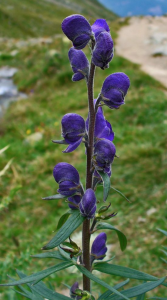
This remedy is of plant origin. Its common name is Monkshood, in recognition of the shape of its flowers which resemble a monk’s hood. It is a poisonous neurotoxic plant, but a very useful remedy for acute conditions when potentised homeopathically.
the early stages (the first 24h) of feverish illnesses when the patient may be anxious though fear may not be present.
It is also a remedy for someone who had had a sudden shock or fright (e.g. accident or heart attack or stoke).
Main remedy in the early stages of croup and also sudden fever – but just in the first 24h and then look to other remedies (which will be described as the series progresses)
You can care for your family with some basic homeopathy and a homeopathic first aid kit.
Starting mid month I am going to share with you the key characteristics of the homeopathic remedies typically found in a first aid kit.
Some homeopathic pharmacies sell first aid kits. In the photo you will see two of the best known.
Taken in alphabetic order, the first remedy will be Aconite and the last Sulphur.
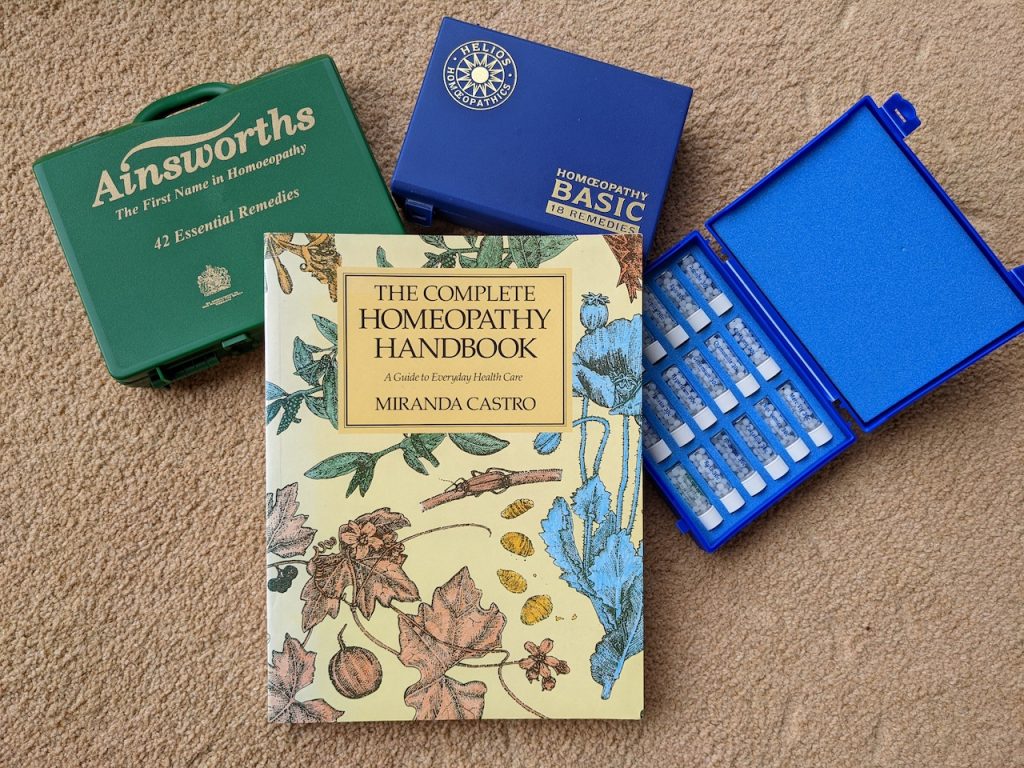
To introduce this series I wish to share the words of the late Dr R A F Jack who was a NHS GP working near Bromsgrove until his retirement in 1980.
With the advent of the NHS, his practice grew. To help limit the number if night calls, he gave every family with young children four bottles of homeopathic remedies for emergencies (Aconite; Belladonna; Ipecacuanha; Chamomilla). In time this very basic kit expanded to 22 remedies.
Below, is his introductory guidance: the words are taken from his book Homeopathy in General Practice (Beaconsfield Publishers 2001 – still available).
“ I would tell the mother that there were five remarkable features about these remedies:
“In deciding which fever pills to use in a doubtful case, I used the analogy of a bunch of keys. If the first key does not fit the lock, it has harmed neither the key nor the lock, and the next key will probably work….”
*(This, incidentally has happened several times. I would tell of one occasion when a child fed all four bottles into a goldfish tank, but a week later the fish were none the worse and continued to swim about unperturbed.)
In a society used to biochemical medicine, that is to say what you get from your local chemist (prescribed or over the counter), the concept of the infinitesimal doses is a challenge.
You need to think in terms of physics and not chemistry.
Consider the homeopathic remedy as a frequency or pattern. Poetically put, music for the soul.
It is a bit like a software download.
The function of a homeopathic remedy is to stimulate an immune response to overcome the condition causing a problem.
This contrasts most orthodox medicines that interact chemically to kill bacteria or ease symptoms by suppressing the natural immune response (e.g. steroid creams for skin complaints).
Homeopathic remedies are made by a serial process of dilution and agitation (otherwise known as succussion).
By way of example, if the leaves of the stinging nettle are crushed and filtered in a mixture of alcohol and water, you have a herbal remedy. One drop of this in 99 drops of alcohol water yields the first centesimal potency labeled 1C. One drop of the 1C potency in another 99 drops of alcohol water yields the second centesimal potency or 2C and so on.
Homeopathic remedies found in the kits shown in the photograph are 30C potency. The lower 12C and 6C potencies are also suitable for first aid use.
Homeopathic medicines are initially made as liquids (termed ‘medicating potencies’) which are then dropped onto pills or tablets. These are more conventient to carry around.
Typically, first aid kits have 2g bottles containing round sugar pills.
The usual dose is one pill or tablet.
For infants, you can crush a pill or tablet between a folded piece of paper to make a powder. Or, you can buy the remedy as sugar granules which comes to the same thing (dose say a quarter teaspoon).
Another trick is to dissolve a pill in a little water (stir well) and give a teaspoon.
Dose
You can safely give 30C and lower potencies three or four times a day over a few days. In an urgent give every 15 minutes over an hour or two.
Some principles:
Do not take Homeopathic remedies over an extended timeframe without professional advice. This would not be first aid. Similarly only give a remedy every hour or less for over 1-3 hours and then tail off.
Expect to see some improvement in 24 hours and conclude treatment within 5-7 days.
Politics, I am afraid, much has changed since Dr Jack’s time. There has long been tension between different schools of thought. Dr Jack clearly found value in homeopathy as did the many doctors he taught.
However, the NHS is wedded to an orthodox western scientific model (which rightly has its place) otherwise known as Allopathy. Medical schools teach this model to the exclusion of alternatives.
In an earlier blog you can read about the difference between the Allopathic and Homeopathic approach
Consequently, knowledge of the homeopathic approach has diminished within orthodox Medicine although the Faculty of Homeopathy still exists for Doctors and Nurses. The Society of Homeopaths and Alliance of Registered Homeopaths are two lay bodies that champion Homeopathy in addition.
Other countries see things differently, especially India.
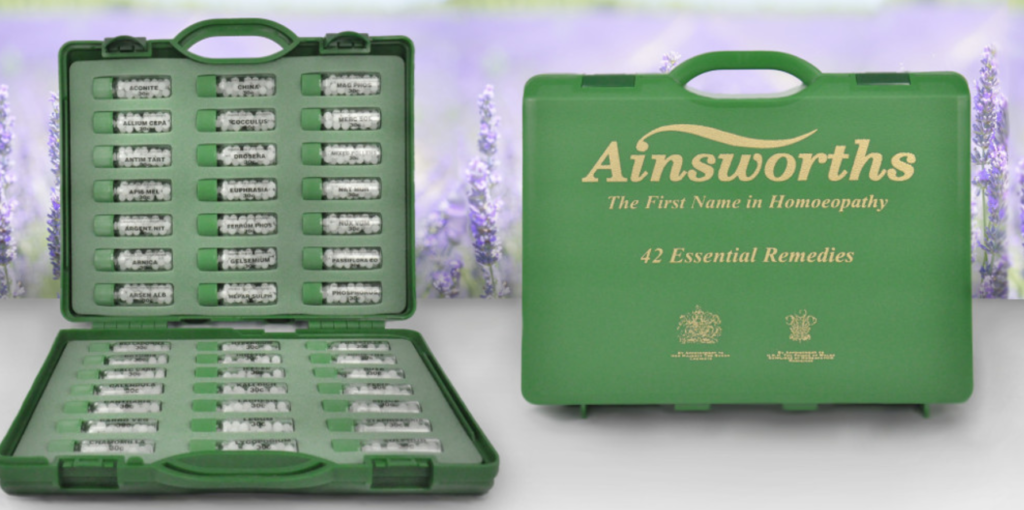
In the past I have shared with you the value in having a small homeopathic first aid kit. Our late Queen carried one. Such a kit is useful for all sorts of ailments.
Over the next few weeks – around mid month – I plan to share with you some of the most commonly used remedies so that you get a feel for how they are used.
To open the series I want to share with you a recent personal experience.
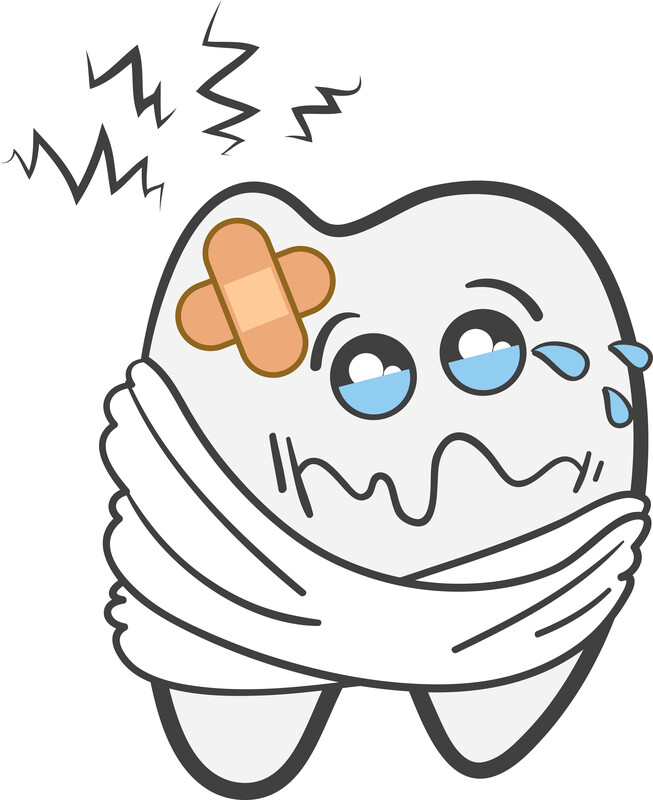
The story begins in February of this year and you may remember I wrote a blog about some neuralgia in my face.
Probably a tooth…? But, a visit to the dentist revealed nothing untoward.
As you would expect I used homeopathy (and I confess Aspirin come 3am). The pain went in a few days, but it is impossible to say whether it was the remedy or just chance.
My regular dental check-up a month later was uneventful.
Bit of a mystery, then!
Come July, I travelled north to visit my elderly Godmother and Aunt near Aberdeen. I had booked into a local hotel, and was awakened at night with a rather sore and swollen index finger on my right hand.
Some weeks before, I had cut the knuckle (poor DIY skills), but it had healed nicely. So infection from the cut seemed unlikely.
In short another mystery.
I had my homeopathic first aid kit with me (always a good idea) and after a bit of consideration took a few doses of Rhus.tox., which in a few hours resolved the situation. This remedy helps with septic states, though it is best known for its value in muscular skeletal injuries (joints, tendons & ligament injuries, also arthritis). The pain eased quite quickly.
To add insult to injury, I was barely dozing off again when an almighty din started up. It wasn’t the alarm clock.
Peeking out the window I saw the problem. A row of swallow chicks…singing their little hearts out. Charming … but!
Here they are, still perched on the gutter, when dawn broke:
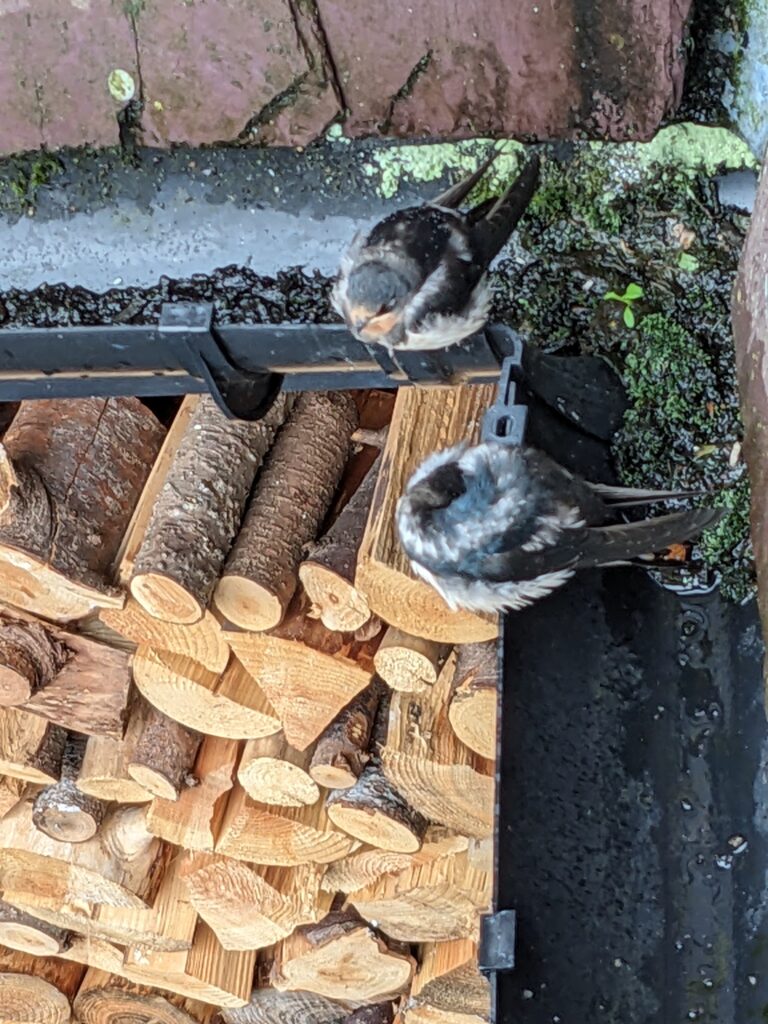
Fast forward to August, and I was off with my wife to Norfolk for a few days.
The neuralgia in my jaw started niggling again. And lo my finger swelled up once more. How bizarre!
Well, Rhus Tox didn’t hack it.
Now you can actually dowse for a remedy, just as you can for water. Though a pendulum is more useful indoors than dowsing rods.
(Dowsing rods like bagpipes are best out of doors).
The pendulum is a sort of amplifier to the innate ability to intuit energy.
Simple dowsing gives a ‘yes’ or ‘no’ answer. For me, it is a rotation clockwise or anti-clockwise respectively.
Once you have a little skill you can, for example, ask ‘do I need this remedy?’ By the swing of the pendulum, then answer is either ‘yes’ or ‘no’.
Phosphorus was the remedy that came to the fore, all rather strange as the remedy has little relevance to swollen fingers. I took it anyway and the swelling went down over a day.
Two weeks later my six monthly dental appointment came around again. By this time it was apparent that the root of the problem – no pun – was a wisdom tooth. In fact it was cracked (old age, I’m afraid!).
A few days later it had to come out, fortunately without too much of a struggle.
Waiting for the dreaded day it was Phosphorus and Staphysagria that kept things calm – no analgesics.
As the dentist rightly said, neither antibiotics (had I taken them) not homeopathics would yield a long term solution. The tooth had failed – simple as that.
Ok, you understand the tooth, but what has the finger got to do with it?
Actually, everything.
Why? Because according to homeopathic philosophy the body works centrifugally.
Think about it from the point of view of the human body.
The tooth is rather close to the brain, a rather vital organ. With infinite wisdom the body acts centrifugally to drive the infection out to the extremities and as far away from vital organs as it can.
And that is why I had a swollen finger.
I already mentioned that in the small print, Rhus tox. is also a remedy for septic states. In contrast, Phosphorus, is a remedy for inflammation of the membranes (linings) of the organs, the nerves and bone – especially the jaw.
Not much to do with fingers, but teeth sit in the jaw.
Back in the day when young girls were employed in match factories where white phosphorous was used extensively, necrosis of the jaw was common – otherwise known as ‘phossy jaw’. I found a nice article (actually anything but) from the Royal College of Surgeons:
https://www.rcseng.ac.uk/library-and-publications/library/blog/phossy-jaw-and-the-matchgirls/
Many went on to die of Tuberculosis.
Interestingly in homeopathy phosphorous is an important remedy in respiratory disease.
The late Dr Donald Foubister (1902-1988) writes:
‘After the war (WW2) I successfully treated over three hundred cases of primary pneumonia in the children’s ward at the Royal London Homeopathic Hospital; in over eighty percent with homeopathy alone and the remainder with homeopathy and penicillin….By far the most common remedies were Phosphorous or Graphites….The correctly chosen remedy would be followed by improvement within 12 hours’ (Foubister D, Tutorials in Homeopathy, Beaconsfield Publishers 1989)
So, the mystery is solved!
Alas I am 25% less in wisdom. But then 25% of a small number is not much!
I have before me a book by the late Dr Jan de Vries, titled ‘Skin Diseases’ first published in 1992. He regularly used homeopathy in the treatment of skin disease.

Photo by Luis Quintero on Unsplash
Jan de Vries was born in the Netherlands, enduring the hardships of Nazi occupation as a child. He trained as a pharmacist but converted to alternative medicine early in his career influenced by a Swiss doctor Alfred Vogel (you will find Vogel herbal products in Health Food shops to this day). Dr de Vries established a clinic in Troon on the West Coast of Scotland, which by the time of his death in 2015, was hugely successful with patients attending from overseas as well as locally. I consulted him once, and it was like a cottage hospital, there was so much going on.
De Vries was a Naturopath, though he also used homeopathic medicines. His approach to skin complaints (indeed all complaints) was to start with the fundamentals of good nutrition, hydration, relaxation and so forth. This is the basis of naturopathy, as the name suggests.
From a homeopathic standpoint also this is sound advice. These factors are the basis of good health. Dr Samuel Hahnemann (who set down the principles of homeopathic medicine) made this quite clear; first put your ‘house’ in order.
That said, they may be insufficient to address an underlying constitutional root cause, which is where treating skin diseases with homeopathy comes in. This is a sort of re-tuning of the life force that animates each one of us.
The skin is one of the largest organs of the body. It extends to 1.5 square meters in a typical adult and every 5 square centimetres contains some 20 million cells. It serves as both a barrier to germs and an organ of elimination through perspiration.
Skin diseases take many forms but the more common are acne, eczema and psoriasis. All three may be influenced to a greater of lesser extent by epigenetic, dietary, hormonal or stress factors. Allergic reactions can also play a part. Then you are unique, which is to say that although your skin condition has the same diagnosis as another person’s it may have a quite different cause.
Strangely, skin conditions whilst maddening – particularly if there is an itch, can indicate a good level of health. This is because the body works centrifugally and, if it can, it will throw problems out to the surface and away from vital organs. Many years ago I had a small outbreak of psoriasis on my elbows and I consulted a naturopath, who told me it was a ‘healthy persons disease’. Of course psoriasis takes different forms some severe enough to require hospitalisation, but in my case the identified trigger was acidity from drinking too much orange juice, so fairly trivial.
Most orthodox treatments for skin conditions focus on managing symptoms. For example, corticosteroid creams have an anti-inflammatory effect and can break the cycle of constant itching. Fantastic as that is, it is not curative. I could have used steroid cream and continued drinking orange juice, but perhaps not the best plan?
There is a well known link between eczema and asthma. Following the centrifugal hypothesis mentioned above, the problem is that when eczema is suppressed the body shifts its expression on the skin to the respiratory system, which is potentially more hazardous.
From the above, you can see that a bit of detective work is required to understand the root cause. This is why the homeopathic consultation takes a little time. Is there a family history of the condition that points to a genetic element? What is going on in your life, and might this be a significant factor? What is your diet like, perhaps what you crave is not what you need? Chemical substances from medications to make-up may be another factor? And so on.
Unfortunately, the treatment of skin diseases with homeopathy takes a little time also. I have some tune-up software on my computer that reminds me as it runs ‘give me a moment, we all wish it was as easy as pie!’
A little time back a young lady consulted me with moderately bad acne. I knew less then than I do now, but nonetheless progress we made progress. Then the stresses of life got in her way which showed up on her skin again. In this situation you might either repeat the remedy, perhaps at a higher potency, or retake the case and change tack. As is every clients right, she chose not to return, noting that ‘it had been a while’. Actually, on checkin I found that it takes just as long to achieve results from orthodox medication some of which has undesirable side-effects.
On the other hand two parents stayed the course. They sought advice for their little girl who had suffered with infant eczema for some time. They had already cut out most dairy products, which are known to cause problems. It was quite a challenging case. Three year olds are happier to scratch than engage in analysis of their skin complaint. From her viewpoint there are more interesting things to do, of course! Her reaction to baked beans pointed the way. As you know beans have a being ‘windy’ reputation, also a characteristic of the homeopathic remedy Lycopodium. For the first time in months the parents got a good night’s sleep.
I now make it clear on my consultations page that resolution for a longer standing problem after one appointment is not really realistic. Perhaps the clue is in the word ‘patient’ though I prefer ‘client’ because the process is about working together to understand and address the root of the problem.
I happen to be a school governor, and on occasion I have to sit on a panel considering whether or not to exclude a child from school for behavioural reasons. Those meetings always get me thinking of homeopathy and mental health.
Without going into inappropriate detail, I recall one case where the child concerned was both disruptive in class and suffered from anxiety. Clearly a mental health issue at the core. Although it is something all schools try to avoid, there really no option but to approve the exclusion. And then we all hope that in due course CAMHS (Children and Adolescent Mental Health Service) will turn things around.
Wearing my homeopathic hat, I saw a different perspective, though as a governor I had to act in accordance with my role and keep my thoughts to myself. That perspective is the general subject of this blog.
Shortly it will be Halloween or the eve of All Saints Day. It marks the end of the summer and has an association with the boundary between the living and the dead, hence ghosts etc. There is a nice explanation of the origins of halloween here https://www.history.com/topics/halloween/history-of-halloween
I lived in Belgium for a while and I recall the churchyards full of flowers – mostly chrysathemums – at this time. And of course there are the traditions of childhood, the pumpkin laterns, ghosts and so on. Here is a photo from my garden of this year’s crop.
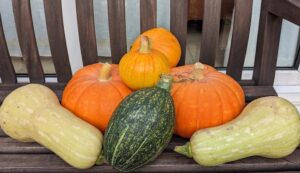
Not much to do with the topic of this blog, you might think. Well, quite.
Yet, Homeopathy uniquely recognises what might be described as ‘ghosts in our cupboards’. Homeopathy and mental health are not strangers.

I introduced you before to Dr Samuel Hahnemann (1755 – 1843), the German physician who set down the principles of homeopathy. For the most part he put a structure to a theory that stretched back into antiquity, that of like cures like, or the law of similars.
However, his real genius was to come up with the concept of the ‘miasm’ (from the Ancient Greek word for ‘pollution’).
If you look up the word ‘miasma’ in a dictionary it has the traditional meaning of some invisible and unpleasant vapour that caused sickness. A sort of smog.
Today we know that the cause was more likely to be contaminated water supplies.
Here is the famous story of Dr John Snow and cholera in London and an amusing cartoon courtesy of the Wellcome Collection (creative commons license).
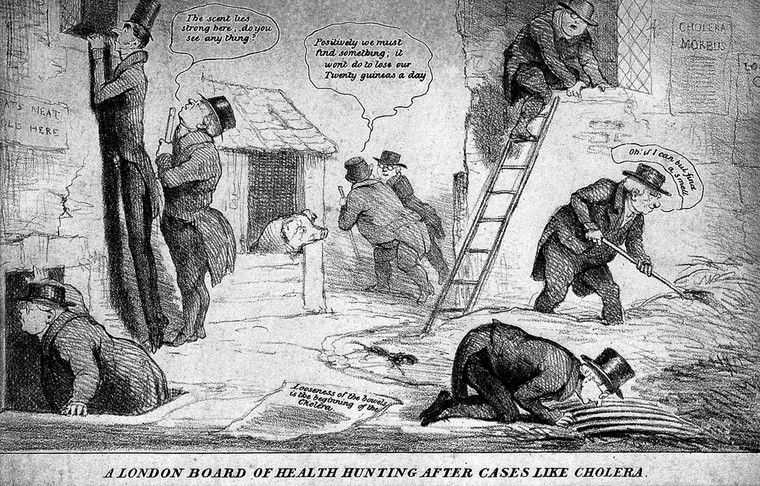
But this was not what Hahnemann meant by the word ‘Miasm’, rather it was something in our inheritance that impeded cure. We are after all the product of our parents, grand-parents, great-grand-parents and beyond … reaching back into history.
Hahnemann’s genius was to touch on epigenetics. Factors that change how your genes are expressed. It is frontier science today and you can find out more here.
This was Hahnemann’s ‘light bulb’ moment.

To give an example, tuberculosis or TB was a disease that was once rife causing death in a quarter of the adult population in the 19th century. It is not much remembered today although antibiotic resistant strains are on the rise again.
Although the rise of TB post dated Hahnemann’s life, his observation was that epidemic / endemic diseases like TB can leave a taint (the miasm) on the genetic code that passes down the generations. This is quite different from the original disease.
This taint expresses itself in our make-up; both mental and physical. It can underly our disease picture especially in chronic long term conditions. If for example you are prone to chest infections or asthma it could be that you are ‘tubercular’ epigenetically speaking.
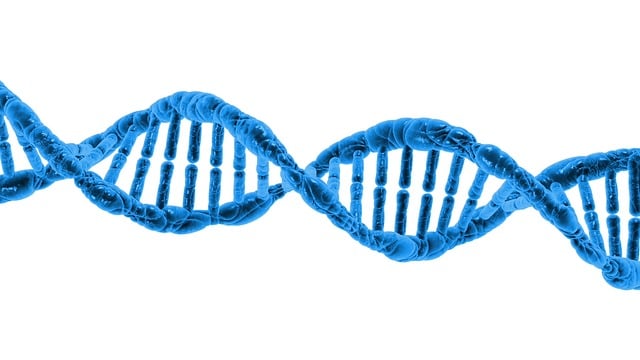
But the influence goes beyond the physical. Tubercular types can be restless, dissatisfied and always seeking pastures new (‘the grass is greener on the other side’). There may be fear of dogs and cats especially in children, who might also be inclined to destructiveness and head banging (in toddlers).
Homeopathy can address this; in a sense it retunes the body.
Homeopathy – distilled down – is about restoring harmony.
Yes, Homeopathy can help with minor ailments at a superficial level, but deep homeopathy starts a healing process and is much more profound.
The pace of change depends to some extent on how long the condition has been present and it does necessitate some commitment. Hence the term ‘patient’!
Homeopathy is not a pill for every ill, nor a quick fix.
If this article about homeopathy and mental health has interested you – please share it with others.
And if you think homeopathy might help you, do take the opportunity of a free discovery call to find out more.
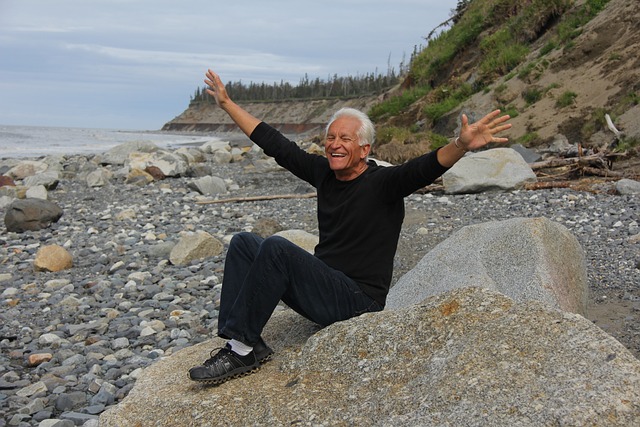
September and October is the time of year when the NHS thinks about boosting immunity in elderly people, ahead of the long winter days, here in Dibden Purlieu, near Southampton, UK. Traditionally, this involves the winter ‘flu jab’ … and in recent years, the ‘COVID booster jab’ too.
We are enjoying an Indian summer but the days are getting shorter. Soon the weather will change and autumn and winter with its respiratory troubles will call. The saying ‘coughs and sneezes spread diseases’ comes back to mind.
I happen to sing with a local choir and I note that there is still a certain anxiety stemming from the pandemic even although the symptom picture of the current Covid strain is becoming hard to distinguish from the common cold.
Homeopathy can help boost immunity and treat these seasonal ailments.
Those of you with long memories may recall I wrote about boosting immunity back in January 2021, when I gave you some pointers for self-help measures you can use. Of course these tips don’t just apply to boosting immunity in the elderly, it is just that as we get older we are less resilient.
Vitamin D supplementation the ‘sunshine vitamin’ helps maintain immunity during the shorter periods of daylight through the winter. Vitamin C is also beneficial especially when fighting off infection, and a short course of the herbal remedy Echinacea can help too. Have all three in your ‘war-chest’!
For some the shorter days and decreasing amounts of sunlight and lead to low moods sometimes called SAD, Vitamin D can help here also.
If you do catch a ‘cold’ maybe think twice about taking paracetamol for any fever. Fever is the body’s natural response and supressing that will slow your recovery. It is better to stay home and rest, eat lightly and take plenty of fluids.
Needless to say, that way you will not spread things around!
Alongside the above, we do well to remember that each of us is different; indeed unique. Simply put we react differently to health challenges.
In the homeopathic consultation I consider your specific symptom picture and match it to the characteristics of the homeopathic remedy.
Whilst most seasonal complaints resolve with some self-care as mentioned above, but sometimes our recovery gets stuck. Should that happen I would encourage you to book a free discovery call, and see how homeopathy might get you back in tip-top shape.
Needless to say, homeopathy can help with many other ailments that come with age be they rheumatic, digestive, traumas emotional or physical and so on. For problems of longer standing homeopathy is not a quick fix, nor a pill for every ill, and it takes a little time to get results, but it is gentle healing that brings results with patience.
P.S. I also help young and middle age ones too.
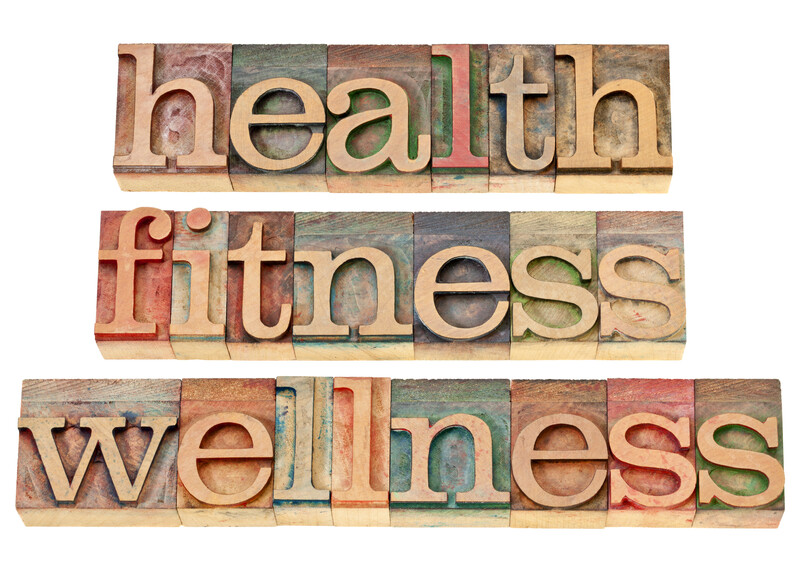
What is the difference between fit and healthy? What do we mean by these words? And what is disease? These words are the subject of this blog.
The homeopathic approach to good health is rather different from that found in most GP surgeries today. It is not a quick fix, but it works at a more fundamental level, and its medicines are not of the nature of modern drugs with their so-called side-effects.
Homeopath and Medical Doctor, Dr David Owen of the Natural Practice in Winchester defines five different models of health in his excellent book titled The Principles and Practice of Homeopathy. These are the Pathogenic, the Biological, the Holistic, the Holographic and the Relational.
The first two (Pathogenic and Bioligical) are the ones that most of you will recognise. A pathogen causes illness and when removed health returns. In the biological model there is recognition that a single cause does not always have the same effect (e.g. stress might induce a headache in one person or diarrhoea in another).
Be it homeopathic or orthodox, these models focus on physical symptoms. Given the time pressures in busy GP surgeries this is particularly so. But drug treatment, particularly if repeated over a long period, brings its own problems.
In contrast the Holistic model recognises that illness may have multiple factors influenced by both the patients nature and environmental factors. We are all different and respond in different ways. This is the dominant model in homeopathy.
The last two categories – the Holographic and Relational – are skills useful in complex cases that the homeopath learns with experience. They are natural progressions from the holistic model.
Dr Owen goes on to compare health and fitness which, he writes, are not the same thing.
I rather like his sentence, “Fitness helps you ‘fit into’ a particular environment or situation”.
Atheletes for example may be ‘fit’ but they are not necessarily healthy, a point I touched on in an earlier blog here.
I wish you now to consider the word ‘disease’, bearing in mind its expression as ‘dis-ease’.
The notable Dutch homeopath Jan Scholten in the opening chapter to his book on Homeopathy and Minerals reminds the reader that Dr Samuel Hahnemann, who set out the tenets of homeopathy in the early part of the 19th century, saw the root of disease to be on the ‘energetic’ and not the physical level.
Hahnemann was a ‘vitalist’ who believed that there is a dynamic force that animates man, which if imbalanced leads to a state of disease and ultimately pathology. (See my earlier blog here.)
Pathogens, environmental factors and inherited traits can all cause imbalance.
Jan considers ‘dis-ease’ under the following headings:
The first two items on the list would be the likely response were you to take a street survey on the meaning of disease.
Wear and tear, is man the machine, where worn out parts need to be replaced, which is appealing in a machine age but not entirely convincing given that our bodies are in a constant state of renewal.
And we need look no further than the recent pandemic to appreciate disease as a threat and our collective response as a war on germs. Again not entirely convincing given that our guts are jammed full of bacteria and viruses with which we have a harmonious existence. The very same germs that make on person sick are often of no consequence to another.
Disease can also be considered a reaction to a state. The Indian homeopath Dr Rajan Sankaran describes the situation of a man being chased by a lion (given his nationality I feel it should be a tiger!) naturally he runs away, fast. Now, say the lion breaks off the chase, yet the man doesn’t realise and keeps running. In this ‘state’ he now risks death from stess and fear rather than mauling!
Then your dis-ease could be a – albeit unintentional – strategy to get attention. A cry for help.
Or it could be an illusion. The late Misha Norland, whom I quoted last month, gives a nice example: the over zealous workaholic sustains himself (usually a ‘him’) by with wine and coffee and ‘burning the candle at both ends’. Cramps, spasms and ulcers result. Eventually, he burns out and just wants to find a quite place for repose, but he believes he cannot because someone has sold his bed – that’s his delusion!
Temptation, Protection and Symbols rather interrelate. It may be tempting to stay ill (unintentionally) so as to protect oneself from addressing other often psychological issues. Your illness is symbolic of some other problem.
Cultural factors can underly disease, consider for example the different ways people handle grief across the world.
Stories (myths) come to us through time and across cultures and often have deeper meaning and finding the mythological key can unlock the door. That ‘key’ maybe found within the experience of those who have suffered in a similar way which of course is the foundation of many self-help organisations.
Finally, man can be seen as the creator of his circumstances, responsible for his disease and situation. But as Jan points out, there lies within the ability to find a solution.
Two fellow compatriates and homeopaths,Ton Jansen and the late Dr Tinus Smits, both suggest that man’s natural state is one of dis-ease; a striving. Homeopathic treatment act as a catalyst to one’s spiritual growth. I rather like that view.
None of the above perspectives are universally applicaple, they are just concepts.
I do hope that you are in robust health today, but life is full of surprises and challenges. You may know only a little about the homeopathic approach to health, but if you would like to know more, please book a free discovery call via my homepage.
That Homeopathy and Christianity are incompatible, as I have occasionally heard, rather puzzles me. I say this a Church attendee throughout most of my life.
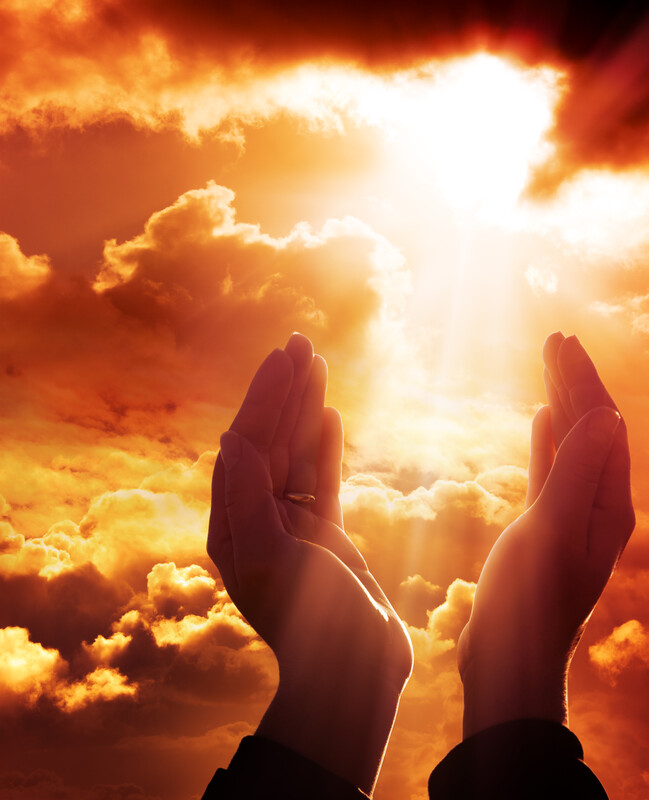
This view is slightly strange as I recall that the family doctor of my childhood in Glasgow – a member of the Faculty of Homeopathy – had an open Bible in the waiting room.
Something of a paradox, then.
This month’s blog introduces the spiritual side of homeopathic medicine in an attempt to address any misconceptions.
That there is a spiritual side to homeopathy is indeed a distinguishing feature over conventional western medicine, for whom spiritual matters are the domain of the hospital chaplain or local priest/minister.
I write here from a general perspective and not of the individual beliefs of doctors or nursing staff.
The impressively named Swiss physician ‘Philippus Aureolus Theophrastus Bombastus von Hohenheim’ better know as Paracelsus (1493-1541) was a notable physician in Renaissance times. You can read about him in this article.
His philosopy anticipated the homeopathic principle of the Law of Similars or ‘like cures like’, in that he perceived that the inner nature of a living thing is expressed in its outer form. It is a sort of signature.
This ‘signature’ can be seen both a picture of our disease (or dis-ease) and in the healing potential of, say, a herb.
Whilst the principle of ‘signatures’ can be overly simplistically interpreted (e.g. a walnut looks like a brain, and therefore walnuts are good for the brain!) a more profound understanding shows the true meaning.
To quote the late Misha Norland who founded the School of Homeopathy (in Stroud):
‘The doctrine of signatures says that by knowing the form of an object, we can know something of its medicinal use; the Language of Nature says that by knowing the name of an object we can also know its form and vice versa.
This way of looking at the world is central to homeopathy, where we become used to thinking in terms of people being “Lycopodium types” or being in a “Sepia state” (Lycopodium and Sepia are two well known homeopathic remedies).
We are simply saying that we perceive a correspondence between a person and a remedy picture.’
Many common names attributed to plants suggest this correspondence, for example Eyebright (Euphrasia).
Johann Wolfgang von Goethe (1749–1832) best known as a man of literature, was also a scientist, who also studied nature in a holistic and non-reductionist way. This contrasted the work of his near contemporary Isaac Newton (1643-1727), for whom Goethe had great respect. Here is a short two part introduction to Gothean Science.
Most recently Dr Edward Bach (1886-1936) used similar intuitive principles to develop a range of flower essences that find good use to this day. His interesting story can be found here.
In short, there are different ways of perceiving; the subjective and objective. Mainstream science favours the objective and is dismissive of the subjective / intuitive, albeit that many notable scientists, past and present (e.g. Albert Einstein) recognise the importance of intuition.
As Misha Norland states, traditional systems of healing such as the Indian Ayurvedic system or Traditional Chinese Medicine stess the need to develop both the powers of observation and intuition. This is a vital process in homeopathy.
Central to homeopathic philosophy is the life force or dynamis. Dr Samuel Hahnemann ( 1755-1843) who set down the principles of homeopathy, wrote of a life force that ‘rules with unbounded sway and retains all parts of the organism in admirable, harmonious vital operation’.
The hermetic tradition, also known as philosophia perennis has the following cardinal principles:
Each of these principles is reflected in homeopathic philosophy, most obviously the last.
Western science has its focus on the physical plane. Consequently, most scientists (though not all) have little interest in the non-material world, or at least compartmentalise that topic away from their weekday endeavours.
Paleontologist, the late Stephen Jay Gould, expressed the division between religion and science as ‘Non overlapping magesteria‘. Sometimes termed NOMA. Drawing from a summary in Wikipedia I find this succinct quotation from Gould in 1997:
‘Religion is too important to too many people for any dismissal or denigration of the comfort still sought by many folks from theology. I may, for example, privately suspect that papal insistence on divine infusion of the soul represents a sop to our fears, a device for maintaining a belief in human superiority within an evolutionary world offering no privileged position to any creature. But I also know that souls represent a subject outside the magisterium of science.
My world cannot prove or disprove such a notion, and the concept of souls cannot threaten or impact my domain. Moreover, while I cannot personally accept the Catholic view of souls, I surely honor the metaphorical value of such a concept both for grounding moral discussion and for expressing what we most value about human potentiality: our decency, care, and all the ethical and intellectual struggles that the evolution of consciousness imposed upon us.’
Respectful as I am of Gould’s analysis of this dilemma, it seem strange to me that religion and science do not overlap or more accurately form some sort of continuum. That such a continuum exists and warrants scientific exploration is central to the work of the Scientific and Medical Network.
Homeopathic philopsophy assuredly recognises this continuum between the spiritual and physical, the non-material life force, animating the physical. Homeopathy is thus perfectly compatible with Christianity (and other religions).
As Norland wrote, homeopathic remedies are based on the concept of provings.
‘Provings were Hahnemann’s brainchild. In a proving a group of stable voluteers of both sexes are given potentised doses or doses of the substance under enquiry. Usually the provers do not know what the substance is. Over a period of time (usually about two months) and under supervision, they keep an on-going log of their altered state. They examine not only new and/or changed physical symptoms, but also mental and psychological symptoms.
Provers are in effect the living instruments upon whom the melody of the musical substance is being played. The collated information constitutes the ‘picture’ of the healing agent.
The proving method of testing the characteristics of plants, animals and minerals in the laboratory of the human body puts homeopathy on a scientific basis in that ‘science’ refers to knowledge that is systematic repeatable and verifiable.’
He continues:
‘Treating a person homeopathically is the opposite process to a proving. We give a sick person the remedy that would cause his symptoms in a healthy person, and the vital force is stimulated in reaction with the result that his symptoms.’
Amusingly then, homeopathy comes under fire from both magesteria. For the ‘fundamentalist’ scientist the non-material world is at best ignored if not denied. Just ‘woo-woo’.
As potentised homeopathic preparations are serially diluted / agitated (succussed) above the 12th centissimal potency they are non-material (according to Avogadro’s number). The conclusion is that there ‘there is nothing in it’ (so just placebo).
On the other hand for the religious ‘fundamentalist’ the non-material / spiritual is sacrosanct and solely to be within the remit of (usually) their particular creed. Potentially, homeopathy is even the Devil’s work!
Needless to say, I contest both views. The role of the homeopathic medicine is to correct a detuned vital force and thereby reestablish the harmonious working of both body and mind. It spans the spiritual and physical. You might care to read this earlier blog.
As a generalisation, our education system is divided between science and the arts. This is another way of expressing Gould’s NOMA. We may have a preference to one path or the other, but our existence is ultimately an amalgam of both. That is to say both a left and right brain undertaking.
As I argued in my recent blog ‘Throwing baby out with the bathwater‘ Medicine must return to equal appreciation of art and science, and reestablishing that balance is the challenge of the current times.
Hahnemann was certainly a scientist before the term was common place. His full name was Frederick Christian Samuel Hahnemann. Was he religious? I cannot say, but nowhere in his writings does he suggest any conflict between Homeopathy and Christianity. His fight was with the orthodox and eclectic medical model of his time, which was all too often doing more harm than good.

© Can Stock Photo / leonido
Homeopathy can help with joint and muscle pain. With early intervention may save the surgeon’s knife. Now, there is no denying the wonders of modern surgery and hip-joint replacement. This seems to have become almost a right of passage when you get to my sort of age. Moreover, these days patients are in and out or hospital quicker than a tyre change by a Kwik-fit Fitter.

Interestingly, in the not too distant past, surgeons where rather the second class citizens of the medical world. Often the last resort.
Should your barber or hairdresser’s premises sport a red and white striped pole, this harks back to the days of the barber-surgeons who would undertake certain surgical procedures as well a giving a ‘short back and sides’.
A Trade Guild was established in 1540 (the livery company exists to this day), but by 1800 the two organisations were split and the Royal College of Surgeons established.
However, what fascinates is when friends tell me that their hip or knee has ‘worn out’. It is Man the Machine. There is of course a certain truth in this, the X-ray or scan doesn’t lie. However, as I pointed out in an earlier blog the cells in our bodies are in a continual state of death and renewal. Apparently some 10 million cells die and are replaced every second. Indeed, I recently read that if you see someone you know after six months or so, not one cell of their face remains from the last time that your paths crossed!
Now if you think about it, the real problem is not wear and tear, apparent as that may be. Rather it is the regeneration ability that has diminished. Clearly the ageing process is a key factor, unless you happen to be the athletic sort in which case aggressive wear and tear might outstrip the ability to repair. As we enter the Wimbledon tennis season, I find it very interesting to compare the likes of Federer and Djokovic with Nadal and our own Andy Murray, the former two having suffered less on the injury front.
The real question is how we might best preserve the underlying capacity of the body to repair and maintain itself.
Dr Samuel Hahnemann of whom I spoke last month, wrote in his Organon of Medicine:
“In the state of health the spirit-like vital force (dynamis) animating the material human organism reigns in supreme sovereignty. It maintains the sensation and activities of all parts of the living organism in a harmony that obliges wonderment. The reasoning spirit who inhabit the organism can thus freely use this healthy living instrument to reach the lofty goal of human existence”
“Without the vital force* the material organism is unable to feel, or act, OR MAINTAIN ITSELF. Only because of the immaterial being (vital principle) that animates it in health and in disease can it feel and maintain its vital functions.
(* Without the vital force the body dies; and then delivered exclusively to the forces of the outer material world, it decomposes, reverting to its chemical constituents.)
“…it is only this vital force thus untuned which brings about in the organism the disagreeable sensations and abnormal functions that we call disease”
Dr Samual Hahnemann, Organon of Medicine 6th Edition, Translated by Künzli et al, Gollanz 1989
Quite simply he is saying that we are animated by an immaterial source of dynamic energy which preserves our health, and if this energy supply is disturbed then disharmony and disease will result.
Logically then it is of great importance to the balance of the body that this flow of energy is maintained. The longevity of our joints depends upon the harmonious existence between the immaterial life principle (vital force) and material (physical) body.
The vital force is central to homeopathic philosophy, a principle that sits well with the philosophies of acupuncture, osteopathy and other systems of medicine (Chinese, Indian etc). Although the precise mechanisms remain obscure it is increasingly clear that potentised homeopathic remedies interact energetically (or informationally) in some manner that restores harmony to the living organism (read again the first paragraph from the Organon of Medicine, above).
Homeopathy may not seem to be an obvious therapy for musculoskeletal injury but there are a range of remedies well suited to such as hip joint disease. Here below are but a few examples with brief characteristics. The task for the homeopath is to match the symptoms of the patient to the characteristics of the remedy. Homeopathy is the application of the natural law of similars – like cures like.
As you proceed down the list that follows, you move from the more acute (short term) to the more chronic (deep seated).
Homeopathy is unlikely to restore established pathology, and as the old saying goes “a stitch in time saves nine”.
Colocynthis – cannot stand / sit, worse for motion, neuralgia and spasm, better for pressure, right sided
Rhus Tox – classically pain on first movement, then eases, better for warmth
Phytolacca – shooting pain like electric shock, swollen hot joints, inflamed periosteum
Pulsatilla – shifting pains, sense of dislocation, worse for warmth in any form
Natrum Sulph – pain extends to knees, better for walking and cold application, worse for damp
Causticum – pain as if dislocated, worse on first motion and lying on hip, extends down or up
This article is a reflection on the long history of homeopathic medicine, a medical system based with a rich history and profound philosophical basis
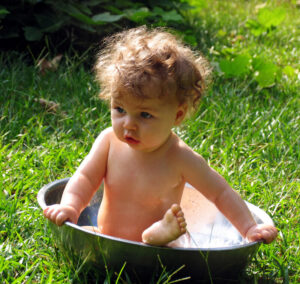
The rich history of homeopathic medicine is interesting. It seems to me that we are rather good at throwing the baby out with the bathwater. Something new comes along and out with the old, lock stock and barrel.

One example that I find interesting is the arrival of the supermarket. I recall as a child ‘Safeway’ (an American company) opening a store in the suburb of Glasgow where I was born. The store, so modest by modern standards, precipitated the demise of the grocers’ shop with its relatively limited stock, yet personal service and even home delivery.
Let’s be fair the new world had much to commend it: light, airy, enticing aisles of shelves and shopping trolleys. It was a revolution, and as revolutions do, it swept away the past. Fast forward and this modest affair would be replaced by larger ‘sooper-dooper’ hyper-markets and out of town malls as we continued to adopt the latest trends from our cousins across the ‘pond’.
Then quite recently something strange happened, these same major supermarket companies started to open local stores and provide a home delivery service; a ‘back to the future’ moment.
We tend to ‘rip up the tracks’ a little too enthusiastically. Reflect on the not dissimilar story of the rise of the motor car and demise of public transportation (Dr Beeching etc.). Or the over enthusiastic demolition of parts of our cities in favour of new-builds, which rather too often turnout to be rather a disappointment to the communities displaced by the new order.
Revolutions are dramatic. However, often the end result is a new problem. The solution may be a ‘back to the future’ moment.
I rather favour evolutionary progress, a spiral movement that appreciates both the new and that which preceded it.
Not ‘Either / Or’ but ‘Both / And’.
What on earth has this to do with the history of homeopathic medicine, the title of this article? The answer is that it is a similar story. Mankind has been around for millennia, in sickness and in health. What we now take to be orthodox medicine, (Allopathy or western scientific medicine), was anything but orthodox to our illustrious forebears. Folk have been getting sick (and recovering) for millenia.
The ability to synthesise drugs is very recent. It was only in 1897 that the German chemical company first synthesised Aspirin. That was just over 125 years ago. The well known antibiotic Penicillin only came into common use in the years immediately after the second world war. You can read about Sir Alexander Flemings discovery here and here. A medical revolution – that of chemotherapy (I use the term in its widest sense), the ‘magic bullet’ – had begun.
The seeds of this revolution originate some decades earlier. So how did this come about?
Modern Scientific Western Medicine (sometimes known as Allopathy) has its origins most notably in the the USA. Scottish-American industrialist Andrew Carnegie made a vast fortune from iron and steel production. In his later years became a major philanthropist, establishing the Carnegie Foundation (‘for the advancement of teaching’) at the beginning of the 20th century.
An academic, Abraham Flexner, whose studies influenced higher education in North America came to the attention of the Carnegie Foundation who in turn commissioned Flexner to evaluate the state of medical education. The result was an radical overhaul of medical education, influenced by the emerging medical science of bacteriology by such notables as Pasteur and Koch. The upshot was the concentration of medical education in relatively few schools, often famous to this day (e.g. John Hopkins), many of which were subsequently funded by foundations such as those of Carnegie and Rockerfeller (J.D Rockefeller, oil magnate). There is no denying the improved academic standards and the establishment of medicine as a lucrative and well respected profession.
What is not to like?
Over dominance of one approach has to diminish another. Either / Or thinking means that there has to be a winner. The winner in this occasion was the scientific-reductionist approach which seeks out the smallest entities in its striving for answers. From cells to nuclei to DNA and beyond. From the naked eye, to the microscope, electron microscope and beyond.
The major industrialist benefactors surely understood the scientific model. Human beings are just sophisticated chemical factories. It all made sense.
A century on, the charitable foundations created by the techology giants, such as the Gates Foundation see things according to their ethos (e.g artificial intelligence and transhumanism).
But we are not (just) machines but living conscious beings. We are a mixture of both the material and the immaterial (or spiritual).
I found it interesting to discover that aspects of Flexner’s recommendations were ignored, particularly in the areas of humanities and ethics.
Other approaches to medicine appreciate a life force that animates us; a life force which out of balance can also lead to disease. I have written on this before. Millions of people across the globe use these medical models and have for many centuries. Often underpinned by Eastern philosophies.
Contrast the ‘Either / Or’ with that of ‘Both / And’.
None can deny the advances in medicine in the last 100 years. But what has been forgotten?
What happened when the lukewarm bathwater of 19th century medical education was tossed out? I suggest that there were twins in the bath. One was nurtured whilst the second was neglected. Especially so in the western world (and the to the greatest exent in the USA and UK).
It is time to redress the injustice.

India is well versed in western scientific medicine (hence the large number of India doctors who serve the NHS). However, the Indian government supports two branches of health care. One broadly follows the western scientific model, whilst the second, called AYUSH, overseas five traditional forms of medicine.
The ‘H’ is homoeopathy. Dr Samuel Hahnemann who set down the principles of homoeopathic medicine is a familiar name in India. Here is a bust in his honour at the Calcutta Homeopathic Hospital.
Curiously slap bang in the centre of Washington DC there is a huge monument to the same man (the first monument erected in memory of a citizen of foreign origin) yet his teachings are all but forgotten in that land. How strange. You can find a picture of the impressive monument at the bottom of my earlier blog here.
To conclude this article, I quote the late Dr Foubister, latterly consultant physician at the Royal London Homeopathic Hospital:
Some years ago Dr Priestman and I had the opportunity to treat some hundreds of cases of pneumonia in the Children’s Ward. We had between forty and fifty admissions each year of primary pneumonia. A few had had penicillin before they were admitted, and in some we used penicillin, but over 90 percent were treated soley by homeopathy. In moribund cases penicillin was given as well as homeopathy, the first to damp down infection and in the second in an attempt to raise resistance. Oxygen was of course administered on the usual clinical indications. [he continues…..] No claim has been made that homeopathy is capable of curing everything. Hahnemann himself taught that it would be absurd not to use treatment other than homeopathy when conditions warranted it, including surgery, which he advocated even in its crude state at that time (early 19th century).
Dr Donald Foubister, Tutorials on Homeopathy (p6/7), Beaconsfield Publishers (1989)
A nice example of Both / And!

Prince (now King) Charles has long been a supporter of Homeopathy and his mother and grandmother before him.
If you live in the United Kingdom you could hardly have missed the Coronation of King Charles III, even if you so wished.
Whatever your views on monachy, few can doubt the new King’s commitment to certain causes.
Some years ago when Prince Charles, he co-authored wrote a book titled ‘Harmony’. I think it rather good. It is a theme that clearly dominates his philosophy of life; namely that we should strive to live in harmony with nature.
One quote in the opening pages is perhaps a good summary of his thinking:
‘if people are encouraged to immerse themselves in Nature’s grammar and geometry they are often led to acquire some remarkably deep philosophical insights.’
His studies into this ‘grammar and geometry of nature’ have resulted in him having strong views on farming, architecture and health. Needless to say he has faced more than a little criticism across the years.
Nevertheless many are at least sympathetic to the principles, and increasingly so. Whatever you may think, he does ‘walk the talk’ and on his farms and estates demonstrates what is possible.
Although best known for his views on architecture and the rural economy, Prince – now King – Charles has long championed Homeopathy.
If there was ever a cause for which a ‘thick skin’ is required, this is probably the one!
As Prince Charles, he was Patron of the Faculty of Homeopathy, and a supporter of Homeopathy at Wellie Level (HAWL) which works with the farming community. You can read his letter of support on the HAWL website (go to the bottom of the HAWL home page).
With justification, in the book ‘Harmony’ he challenges any who consider homeopathy as just placebo medicine, to explain why it works on animals.
As an aside, the principles of biodynamic agriculture share common ground with homeopathy also. Thus, it is not just humans and animals that benefit but plants also.
Sadly the scientific-materialist mindset resists thinking ‘outside of the box’. That ‘box’ is the biochemical model, that sees us (and animals and plants) as just sophisticated chemistry sets. A rather narrow view, in my opinion, and about which I have penned a blog before.
Homeopathy has a Royal History
Homeopathy has a long history within the Royal Family. In his book ‘Samuel Hahnemann, The Founder of Homeopathic Medicine’, Trevor Cook PhD FRSC, a former managing director of Nelson’s Homeopathic Pharmacy in London (est.1860), believes that the wife-to-be of King William IV, Princess Adelaide of Saxe-Coburg-Meiningen, was the first to use homeopathy.
Her uncle, Duke Ernst of Saxe-Coburg-Gotha, brought Hahnemann to Geogenthal (Thuringia, Germany) in 1792 as physician to be in charge of an asylum there. Queen Adelaide was an aunt of Duke Ernst’s second son Prince Albert who married Queen Victoria.
More recently, Queen Mary (1867-1953), Consort to King George V, is known to have revived the family interest in homeopathy.
Trevor Cook goes on to write:
‘Royal patronage now spans more than 160 years to include King Edward VIII (1894-1972) who, as Prince Edward, Prince of Wales, invariably carried his homeopathic medicines in powder doses in his pocket. His brother, King George IV (1895-1952), named one of his racehorses ‘Hypericum’ after the King had successfully been treated by the medicine’.
Hypericum is a homeopathic remedy to used treat nerve damage (e.g. crushed fingers).
A small box of homeopathic remedies also accompanied our late Queen Elizabeth II on her many travels.

Ainsworths Homeopathic Pharmacy holds the Royal Warrant to this day as you can see on the cover of their remedy kit.
Long live the King!
Long live Hahnemann!
Can Homeopathy help anxiety and depression? That is the question.
We can all have a bit of a wobble. This can be for any number of reasons: a consequence of some event in the past or anticipation of an event to come.
The root cause may even reach back to an event in the distant past (in homoeopathic speak – ‘never been well since’).

The situation can therefore be transient or long-term. Another way of putting this is acute or chronic. I introduced these terms in last month’s blog.
By way of example, the plant Arnica Montana is well-known as a herbal product that helps heal bruising. As a homoeopathic preparation, it can both be used in cases of a recent injury and to overcome past traumatic events.
Here is a short eight minute YouTube video from Professor George Vithoulkas at the International Academy of Classical Homeopathy in Greece. The sound quality could be better, but bear with it and you will get a good appreciation of the remedy.
Prof Vithoulkas makes a really good point at the end of the video: in short, respect the homoeopathic remedies. We all have emotional ups and downs. It is part and parcel of life and something with which we cope without medicine, be it homoeopathic or orthodox (allopathic). Similarly, we don’t need a remedy for every cold and sniffle. Our innate systems will bring us back into harmony.
On the other hand, sometimes we are knocked off balance and struggle to bounce back. Or we struggle to cope with a situation, past or to come. This is when help is needed.
For more immediate – first aid – situations Pharmacists Drs Steven and Lee Kayne, have published a little book with flowcharts that aid the selection of appropriate homoeopathic remedies.
Very clever!
You will find full details of their book here. The remedies themselves you may order from their pharmacy (Freemans) or others such as Ainsworths, Helios or Nelsons.
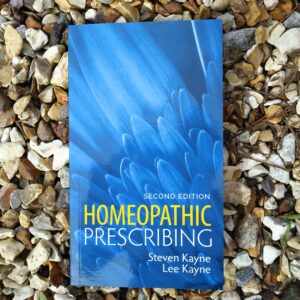
To give you an idea, I show below a sample page reproduced with the publisher’s permission. Although a flowchart may be a simplification of the art of homoeopathic prescribing, it nonetheless gives you an appreciation of the remedy selection process.
Key to homoeopathy is the law of similars. Your state must align with the essence of the remedy. George Vithoulkas explains this well in the YouTube clip linked above.

Harmony and balance are keywords in homoeopathy. The goal of the homoeopathic remedy is quite simply to restore the human organism to harmony and health.
The bottom line: homoeopathy can help either on its own but also effectively alongside other therapies, be they pharmaceutical or counselling.
https://www.instagram.com/p/Cqsag1LohBn/
A more practical topic this month: homeopathy for tooth nerve pain or neuralgia

My problem being a neuralgia, on the left side and lower jaw of my face. Tooth nerve pain was the likely cause.
It didn’t improve my humour! And it got me out of bed at 3am for a few nights.. 🙁
This blog explains the homeopathic approach to neuralgia.
Dr Samuel Hahnemann – of whom I have written before – set out the principles of homeopathy. He classified two types of disease (aphorism 72 of The Organon of Medicine).
The common coughs and colds sit with the first group, and such as arthritis or eczema – and much more besides – sit with the second.
The first we recover from without much intervention, the second we do not.
To set the scene, here is a very funny sketch from the USA (Carol Burnett Show). Lest I risk censure – my dentist is highly competent!
So, I have this sensitive tooth and expect it to pass but it doesn’t. I have not had a filling for many a year, but have all too many from a misspent youth (remember “a Mars a day helps you work rest and play“…beware slick marketers!).
Alas it didn’t pass, so my kindly dentist fitted me into his busy day. Alas the visit was inconclusive were fine; even the x-ray. He gave me an antibiotic prescription on an “only if needed” basis.
The cardinal signs of inflammation are long known: warmth, redness, pain, and swelling or in the words of the Roman Aulus Cornelius Celsus (25 BCE – 75 CE) calor, rubor, dolor, and tumor.
At best I scored a shakey 2 out of 4.
So I didn’t take the antibiotics.
I cannot say that I have had tooth nerve pain as intense before and I don’t commend it. Least of all because of disturbed nights.
It could have been much worst – there is a very painful condition known as trigeminal neuralgia where the pain is much more widespread.
In the ‘wee small hours’ I confess to taking an Aspirin something I have not done for many a year.
Homeopaths classically work between two books: Repertory and Materia Medica (often computerised these days).
The Repertory give some pointers as to possible remedies and the Materia Medica detailed information on each remedy.
The selection of the most appropriate remedy is based on the Materia Medica. Here is one classic online example of the Materia Medica by William Boericke MD.
First, I did a simple repertorisation as shown below: symptoms on the left and possible remedies on the right.

I did not take Verbascum because I didn’t have it in my box.
The ‘picture’ of Causticum did not seem to fit – remember in homeopathy you match the picture of the remedy to the symptoms of the patient.
In the end I alternated Spigelia and Colocynthis.
Spigelia was perhaps the best choice. In a short description from Dr Andrew Lockie in his Family Guide to Homeopathy he writes “Neuralgia on left side of face, tearing pains, twitching muscles, noise makes symptoms worse, pressue makes them better”.
At any rate after a few days everything settled down.
Might it have got better anyway? – quite possibly.
Had I taken the antibiotics, I would have said they worked! But I didn’t, rather I used homeopathy and self-prescribed on homeopathic principles.
All I can say is that Spigelia has a reputation in neuralgia of the facial nerve.
It boils down to a balance of probabilities.
So Spigelia worked – maybe! And I am glad the pain is gone.
But in the end the purpose of this short blog was to simpy share with you the homeopathic method in the management of an “acute”.
The clinical trial, I leave to others.
There is a part two to this story which you will find in another blog here
https://www.instagram.com/p/CopF5p9IP2N/

That water has memory is key to homeopathy and frontier science.
When it comes to our physical body there are some remarkable statistics:
(from Unfolding Consciousness by E. Bilimora, 2022, Shepherd-Walwyn Publishers)
Added to that we are substantially water – roughly two thirds by volume. Indeed over 99% of the cells in the human body are water. (the residual 1% of a million, billion is still quite a lot of other stuff!)
All of which says that we are like a river flowing through life. No moment in time is the same. Life is dynamic not static.
Back in November and December I introduced you to Dr Samuel Hahnemann who is credited with setting out the principles of Homeopathy in a small volume titled the Organon of Medicine. It ran to six editions and it is still in print. He died in 1843 at the age of eighty eight.
He was undoubtably a polymath: a translator (he knew a dozen or more languages), a chemist and a medical man.
Hahnemann certainly believed in a life giving or vital force, and so do I. Sooner or later we all experience the death of someone close to us and it is a remarkable fact that at the instant of death nothing really changes at the molecular level, but the conversation stops. What is going on?
Modern medical science is rather dismissive – in fact the nature of ‘life’ is barely mentioned. You might care to ask your doctor his or her views! I suspect you will get a more interesting answer from those working in palliative medicine.
Not so long ago the concept of a life force was taken for granted. As an aside, most Scots of my age will remember the TV adaptation of Neil Munro’s Para Handy, the wily captain of a coastal ship (steam ‘puffer’) named the ‘Vital Spark’. Those living on the islands on the west of Scotland were – and still are – in tune with their nature.
Hahnemann might have had a simple microscope but little more in the way of technology. He was however a skilled observer of his fellow man and a scientist ahead of his time.
It was in the half-century after his death that an understanding of the inner workings of the body developed (bacteriology, x-rays and so forth). And through the 20th century medical science brought even more sophisitation. To this day the focus is on the inner workings of the body.
However, Hahnemann saw things differently. His view was that disease is fundamentally a disturbance of the vital or life force. To quote him:
‘So it is the totality of symptoms, the outer image expressing the inner essence of the disease, i.e. of the disturbed vital force, that must be the main, even the only means by which the disease allows us to find the necessary remedy, the only one that can decide the appropriate choice.‘
Organon of Medicine, Dr Samuel Hahnemann (extract from aphorism 7)
‘When I speak of disease as a tuning or untuning of the human economy, far be it from me to attempt a metaphysical explanation of the the inner nature of disease in general or of any particular case of disease. I am merely pointing out that the diseases obviously are not and cannot be mechanical or chemical changes in the material substance of the body, that they do not depend on a material disease substance, but are an exclusively dynamic spirit-like untunement of life‘.
Organon of Medicine, Dr Samuel Hahnemann (footnote to aphorism 31)
Now I think it obvious that he was not talking about, say, a broken limb when there is clearly a mechanical cause. Rather, he says that in the absence of an obvious cause, your root of your illness is a vital force untuned.
So [he says] first remove any obvious cause (see January blog), and then bring the vital or life force back into balance (by homeopathic or other means).
Last week the composer Burt Bacharach died, who with lyricist Hal David penned ‘I’ll never fall in love again” – here is a verse that comes to mind:

What do you get when you kiss a guy?
You get enough germs to catch pneumonia
After you do, he’ll never phone ya
I’ll never fall in love again
I’ll never fall in love again
My point is simply that how we resonate with another person has consequences; good and bad. This is a disturbance of the vital force.
In more general terms how we resonate with our environment can bring about ease or dis-ease.
In homeopathy there is a concept of NWBS (never been well since). Often that can be a traumatic life event.
Coming back to water and to quote the famous line from Coleridge’s The Rhime of the Ancient Mariner.
Hahnemann, nineteeth century, old hat. Look at the achievements of modern medical science. Maybe.
Yet…

The late Dr Masura Emoto in Japan did some interesting work on the affect of emotions on the crystalline structure of water. You can find many images on his legacy website here. Fascinating stuff.
Does this not suggest that our water full bodies do indeed resonate with our emotions? I think so.
Another scientist working on the properties of water is my near namesake and scientist Dr Gerald (Jerry) Pollack . He leads a team of researchers at the University of Washington
Smart guy. What a difference an ‘a’ makes! (Pollack/Pollock)
Water is a strange thing. A combination of hydrogen and oxygen atoms, it can dowse a fire. Yet as someone wryly observed, puting hydrogen and oxygen on a fire is – in contrast – not a good idea.
Back to Jerry Pollack, he and his team propose a fourth phase of water. The first three you know – liquid, solid (ice) and vapour (steam). The fourth is a liquid crystal like state which he terms EZ (‘ee-zee’ in US pronounciation) meaning Exclusion Zone. It does seem to act as a barrier, but there are wider discoveries.
Without going into detail, this fourth phase has properties that may have significant implications for health. You can get an idea here. Jerry Pollack concludes that EZ water is an energy store (battery) and energy delivery mechanism. Light in the infra-red spectrum (e.g. sun) is a key driver; one reason perhaps why we all feel better in the sunshire.
The potential of EZ water to store information through subtle changes in the lattice structure is an important area of current research. But information from where. I suggest it might be this enigma, the vital force.
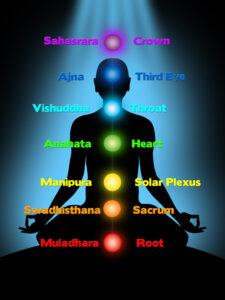
Ancient wisdom from India and beyond, has long recognised centres of energy in the body. You may be familiar with is chakra, especially if you practise yoga.
The seven principal chakras are shown in this picture and they run along the spine (though most images are from the front of the body).
The word chakra means a disc. Each is a vortex of energy relating to nerve centres in the body. They are invisible yet they can be sensed by some.
Systems of medicine such as Ayurvedic (India) and aspects of Traditional Chinese Medicine (e.g. acupuncture) seek to balance these centres and maintain a free flow of energy.
There is as yet no precise meaning of the word ‘energy’. We’re not talking about coal! Einstein showed that matter is energy (E=mc2) and cosmologists like Jude Currivan present a good case for ‘energy’ equating to ‘information’.
From the above you can start to join the dots. We humans are mostly a column of water, nourished not just by food, but ‘informed’ by a type of energy; a life or vital force. This energy ‘informs’ may flow via the chakras. And the water of which we are made may receive and store this energy / information, rather in the manner of a software download.
Without the life or vital force we die. We are spiritual (immaterial) beings living a material existance for a while.
This is perhaps most apparent with the development of the foetus, which miraculously delivers a baby from the starting point of the simple division of a single dividing cell. In adulthood these same forces (call them what you will) repair our injuries and keep us healthy to the best of their abilities.
The flow of vital force when distrubed is dis-ease (two words). This disturbance may be transient and self-correcting. If not, in time physical symptoms may emerge.
Acupuncture seems to unblock pathways. Homeopathic medicines which are potentised ultra-dilutions (in water) are likely information carriers which act subtly on that water which is us.
Medicine today is focused on the biochemical. All well and good, but both emerging science and ancient wisdom suggest that there are other paths to healing.
https://www.instagram.com/p/CopF5p9IP2N/
I heard someone on the radio saying that we are living healthier and longer lives than ever before. In fact it is a mantra that is often stated. We take such a statement at face value because it seems to make sense, after all the average lifespan in the UK is just north of 80 years which is a good deal greater than the Biblical “three score years and ten”. And of course childhood mortality is now very low. So far, all for the good.

On the other hand, back in ‘lockdown’ when I cycled out into the New Forest and took a wander round a few rural churchyards, I was rather surprised to see people living to a good age a century of more back. Some into their eighties, which I suppose – being the strongest consitutions – would be ninety year olds of today.
I find much the same in rural churchyards I have visited elsewhere, though my analysis is hardly comprehensive.
Curiously, 34 seemed to be a hazardous age in one cemetery in the Outer Hebrides, my guide – a local man – was 43, and so I congratulated him on his achievement!
But seriously, it got me thinking about health. Are we truly healthier? What is the secret to living longer and healthier?
One of the wonders of the internet age is the ability to do a little armchair analysis. The NHS statistics service (NHSBSA) tells us that the cost of medicines prescribed in primary care in England was £9.4 billion in 2020/21, 55% of the total drug expenditure (hospital prescriptions making up the other 45%).
Seems to me that if we were truly living healthier lives, that longevity would not come at this cost.
That my wanderings have been into rural cemeteries in Britian is significant. I suspect the story in the industrial cities would be very different. Factory life was harsh. Social class was and remains today an important factor in health and lifespan.
So, my hypothesis could stand or fall on the data I choose to select (a subtlety not lost on those who write ‘scientific’ papers today, by the way).
Still, I will hazard a guess that rural communities who lived by the seasons, in unpolluted environments, ate simply, and worked hard but suffered low stress, were quite healthy. At a time when there was not much medical intervention either.
We need to understand why our drugs budget is so high. NHSBSA have some revealing statistical collections that tell us that:
Needless to say, the most deprived areas received the higher proportion of the prescriptions.
Drug cost is just a part of the picture. The drugs are a short term fix. In the longer term health conditions become more complex and more costly, especially where in-patient care is required.
How do you react to these figures?
Cardiologist Dr Assem Malhotra has some interesting observations – here is a recent interview with Dr Ken Berry MD on YouTube. It is worth a watch.
It should not come as a great surprise that the Malhotra and Berry conclude that the fundamentals of health for most of us are quite simple
I have written before about colour and diet, here is a nice photograph to illustrate the point.

Were it possible to go back in time and apply a light touch of modern medical practice, I rather think the longevity of our ancestors would match that of today, with better underlying health. By light touch, I mean simple steps to reduce infant death, handle trauma, and acute life threatenting conditions.
Towards the end of the interview Dr Malhotra explains the true cost to health of poor diet.
In this topsy turvy world is it not strange that ultra-processed food is cheaper than fresh simple food? Deprivation and disease go hand in hand.

I suppose this blog should be about homeopathy, yet no mention thus far. Well, here is a snippet.
Last month I wrote about Dr Samuel Hahnemann, generally considered the founding father of homeopathic medicine, who makes it very clear in his profound book, The Organon of Medicine that removing obstacles to cure is the first step to health. Here are his words written in the early 1800s:
It is obvious that every reasonable physician will first of all remove the causa occasionalis; after that the indisposition usually disappears on its own.
Organon of Medicine, Aphorism 7 footnote (in part) – Dr Samuel Hahnemann
It’s the old saying “a stitch in time saves nine”. So what might you sew (or sow) in 2023?
https://www.instagram.com/p/CnMSdUPo5JW/
This blog argues that both allopathic and homeopathic medicine have a place in medicine today.
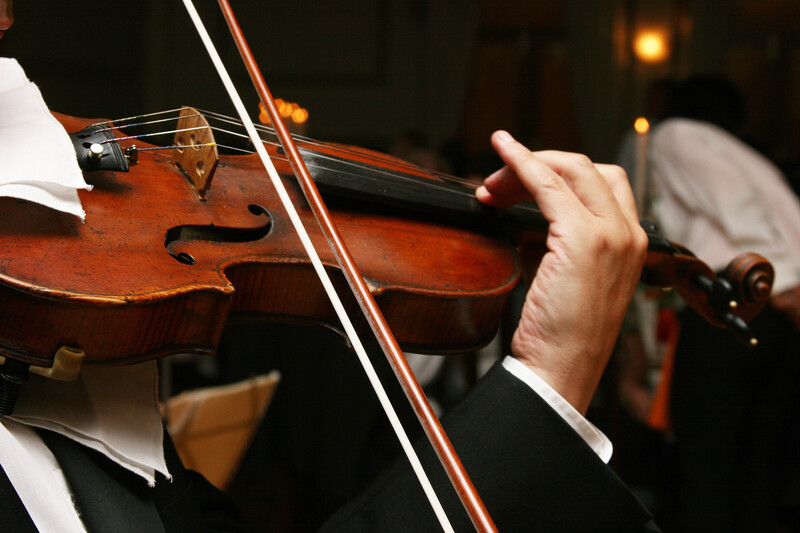
I am not a musician, but I am told that a good violinist can – within limits – continue to play on three strings should the fourth break. The words of the song “three wheels on my wagon and I’m still rolling along” come equally to mind.
What I wish to argue is that modern western medicine is playing on three strings. There is a missing dimension. Substantially this comes about because the entire focus of medical science is on the material world. Consequently most people today perceive the world only in material terms. All things can be seen, we just need the right technology (e.g. electron microscope and beyond).
Of course there is an obvious flaw here as our emotional life which finds expression in beauty or grief or love is anything but material. This is resolved by stating that our feelings are derived from a material source, such as variations in brain chemistry.
The three major strings (therapies) of modern western medicine are surgery, chemotherapy (all drug therapies) and, radiotherapy. Put crudely it is cut, poison or burn. That there is huge competency in these therapies is not in question; after all billions of dollars are spent annually in pursuit of refinements.
This philosophy is clear: the solution to disease is fundamentally surgical or chemical (drug). There is a material problem that needs a material solution.
Let’s consider the matter of joint replacement.
Friends who have had hip replacements or such like are justifiably impressed with outcome. The diagnosis from patient and surgeon alike is that hip was “worn-out”. A bit like some component in your car.
This is interesting because living bone is not the dessicated remains found in an archeological dig, but made of living cells; were it not so, broken bones would not heal. In fact your cells are in a continual dynamic state of death and renewal. So it is not the hip that is “worn-out” but the ability to self-repair. What drives that? And who is researching this? [answer: barely anyone]
Materialist science is not without its critics and I have mentioned the Galileo Commission before. In my March 22 blog I quoted a notable American homeopath in the early years of the 20th century:
Most of the conditions of the human economy that are called diseases in the books are not diseases, but the results of disease. To call a group of symptoms a disease of one part, and another group of symptoms a disease of another part, is a great heresy….. Organic disease is the result of disease
Lectures in Homeopathic Philosophy, Lecture IX Dr James Tyler Kent
This is a little challenging, but what he is saying is that your pathology (organic disease) is the result of a non-material disturbance (untuning) of the life force that animates you.
So long as science has a purely material focus, the ultimate potential of the healing arts is constrained.
Last month I introduced you to Dr Samuel Hahnemann. He set out the principles of homeopathic medicine and the monument in his honour in Washington was the first to a non-American. His genius has been rather forgotten.
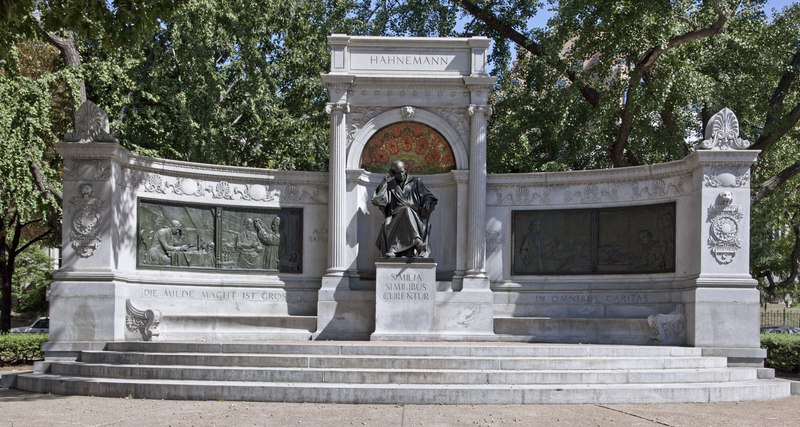
photo: Carol M. Highsmith, Public domain, via Wikimedia Commons
Hahnemann’s most famous work is The Organon of Medicine a book still in print some 180 years after his death in which he writes:

When I speak of disease as a tuning or untuning of the human economy, far be it from me to attempt a metaphysical explanation of the inner nature of disease in general or of any particular case of disease. I am merely pointing out that the diseases obviously are not and cannot be mechanical or chemical changes in the material substance of the body, that they do not depend on a material disease substance, but are an exclusively dynamic, spirit-like untunement of life.
Organon of Medicine, Dr S Hahnemann. Footnote to aphorism 31
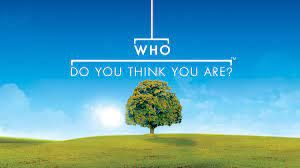
Such is the title of a well know BBC television series. It is a good question and one I touched in my blog of June 2021 which I illustrated with an image of another BBC icon of years past Mr Blobby.
We are in fact mostly water – at least two-thirds. And when you add in the rest of the ‘soup’, we are really more fluid than solid.
Dr Rudolph Steiner – a notable polymath from the early years of the 20th century – described the human being as a column of water. He is probably best known today for his views on education (Waldorf / Camphill schools).
Everyday – though we are oblivious to the fact – thousands of cells die and thousands of new cells replace them.
We are as a stream flowing through life.
Something must drive this.
The vitalist philosophy – to which Hahnemann, Steiner and others subscribed – perceives a life or vital force as the ‘driver’, though it is invisible.
Without this the body reverts to the elements (death).
Which is the latin for “not welcome”, nicely encapsulates the scientific materialst view on the concept of any vital or life force. Francis Crick (co-discoverer of DNA) assuredly was not a fan:
Exact knowledge is the enemy of vitalism
Of Molecules and men (1966) Francis Crick
None doubt his brilliance, but Hahnemann, Steiner and others were brilliant also.
So you just have to choose your ‘poison’, but…
A familiar phrase from BBC’s Dad’s Army. Unfortunately, there is a tendancy today to denigrate by name calling fine minds past and present who do challenge conventional wisdom. In short, “permission to speak” is denied.
Here are some examples:
Steiner’s views get a pasting on Wikipedia (Anthroposophy)
Dr Malcolm Kendrick, discusses the death of medical research in his recent blog.
And finally:
Dr Tom Cowan MD from over ‘the pond’ who challenges convention and is shunned in equal measure (see quote below).
Progress cannot be made in biology, Cowan argues, until we recognize the fact that our cells are composed primarily of structured water, and that water is subject to influences from outside the cell: “. . . light and all the various frequencies, energy forms, wavelengths, sounds, colors, thoughts, emotions and other emanations that come to us from the universe.” Wellness occurs when we provide our cells with all that is noble and perfect—nutrient-dense food, sunlight, clean air, pure water, a coherent and native electromagnetic atmosphere, truth, freedom and love—not by poisoning them with vaccines and drugs.
https://www.westonaprice.org/book-reviews/breaking-the-spell-by-thomas-s-cowan/#gsc.tab=0
Allopathic AND Homeopathic Medicine: Time to replace the fourth string on the fiddle?

Just a thought…
Have a good Christmas
https://www.instagram.com/p/Cl62o1Vo8fQ/
This blog is about remembering the past and specifically the benefits of homeopathy.
The thing is we do forget. The eleventh hour of the eleventh day of the eleventh month is soon upon us and it serves indeed as a reminder of past conflicts.
But I suspect for most youngsters the two world wars might as well be the Battle of Hastings or Waterloo, though surviving film footage does resonate across time. My late father served in the western desert and Italy in WW2. Were he alive he would be now 106!

Of course it is not just about conflicts distant in time. I read this weekend the report of a recent train derailment (2001) in Scotland, fortunately without casualties. The investigators found that it had much in common with the 1988 Clapham rail disaster (wiring error) which cost the lives of 35 people.
The late Trevor Kletz, whom I once met in my Chemical Engineering days, wrote many books on the theme of “What went wrong” – to quote one title. It had a sequel, “Still going wrong”, reminding readers of the shortnes of corporate memory.
I recall him quoting a boy on the radio who notably said that “he didn’t have a memory only a ‘forgett-ory'”. Quite.
Alas, we forget the past and consequences follow.

Not all amnesia is entirely accidental. All too often the past is denied; inconvenient truths and wisdom brushed aside. The reasons are mixed, there may be gain (corporate or personal), or maybe just a biased manner of thinking.
Just over a century ago John D Rockefeller and Andrew Carnegie were the equivalent of today’s Bill Gates, Mark Zuckerberg and more. Through their wealth they funded various charitable foundations that had great influence.
I don’t wish to say that they were bad people. Carnegie, whose humble beginnings were in Dunfermline, Scotland funded many public libraries throughout that land and beyond (the link opens with a picture of my local library in Rutherglen, where I was born).
However, what the poweful have is influence to move society in the direction they believe is best. In this towards what we know as western scientific medicine or allopathy (not that homeopathy is unscientific – anything but).
The gentleman was an a academic engaged by the aformentioned to look into medical training in the USA.
Here is a nice summary of his contribution.
Medicine is generally recognised as a balance between art and science. Science today is solely focused on the material world, a subject I have touched on before. However, human beings are more than a bundle of molecules.
There is a growing concern today that the application of science is too narrow and you may care to read the Galileo Report of the Scientific and Medical Network.
The picture below is of a monument located in the centre of Washington D.C. The first monument in that city to a non-US citizen (he was German). Who was this man to get such a grand monument?

Hahnemann (1755-1843) is considered the founding father of homeopathy. A scientist before the term was in general use and polymath (he knew many languages). His medical work was of huge significance. Here is a short summary from the Journal of the Royal Society of Medicine. Yet you wont find mention of him in western medical schools today.
Homeopathy was a major force in America at the start of the twentieth century. It’s demise stems from the influence of Abraham Flexner and his sponsors.
Medicine was set a path to that which we see today. There have been many benefits, but all in the garden is not rosy as the burden of prescription costs to the NHS might attest.
I suggest – well obviously I would! – that we need to look again not just at homeopathy, but naturopathic, and medicine in all its forms practiced throughout the world.
Medical science today is too narrow in its application and the ‘art’ has all but disappeared (though many physicians still recognise the art in what they do).
Hahnemann’s seminal work is the Organon of Medicine, which is still in print. The opening aphorisms shown below speak to us through time. The rest is not bad either – actually, very profound.
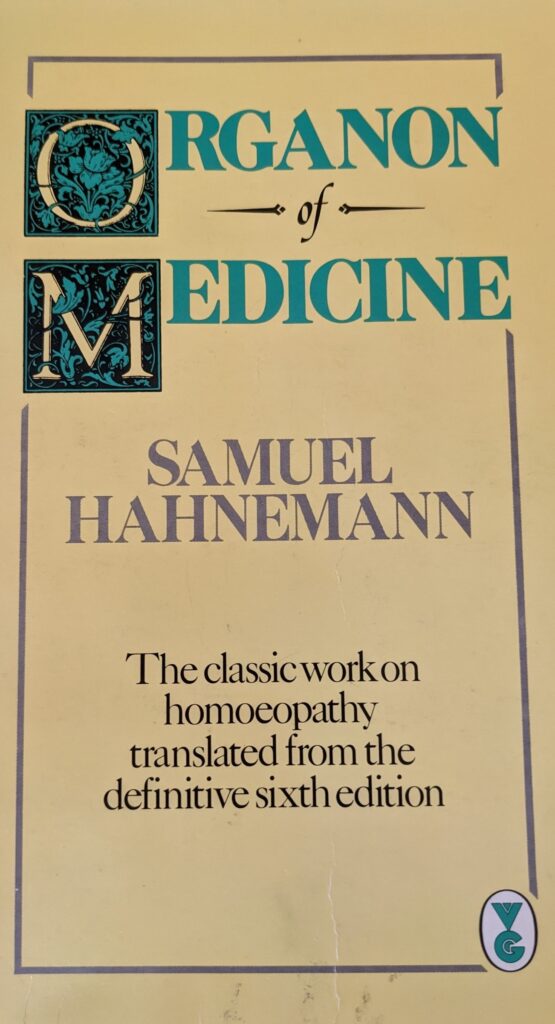
Aphorism 1: The physician’s highest calling, his only calling, is to make sick people healthy – to heal as it is termed.
Aphorism 2: The highest ideal of therapy is to restore health rapidly, gently, permanently; to remove and destroy the whole disease in the shortest, surest, least harmful way, according to clearly comprehensible principles.
Dr Samuel Hahnemann, Organon of Medicine
This week a letter came through the door from the NHS inviting me for a Covid booster jab. I still await guidance on building natural immunity to Covid. Having all become armchair epidemioligists / virologists in the last few years, I find this approach fascinating. By now we all know how much of a ‘shape shifter’ this virus is, and no sooner have the scientists unraveled the code of one variant, then another pops up.

Then we infer boosting is all benefit without risk which would appear to be a subject worthy of discussion. Just last night GB news ran this interesting news item. I will leave you to make your own assessment. What worries me is the lack of informed consent.
However, the good news is that we do know that the virus is now milder and with some sensible precautions you will survive. My father-in-law at 88 returned from an overnight hospital stay with a farewell gift (Covid) and coped fine.
I want to talk about self help. A little refresher from what I penned almost a year ago. Let’s start with Vitamin C, which is has excellent anti-viral properties
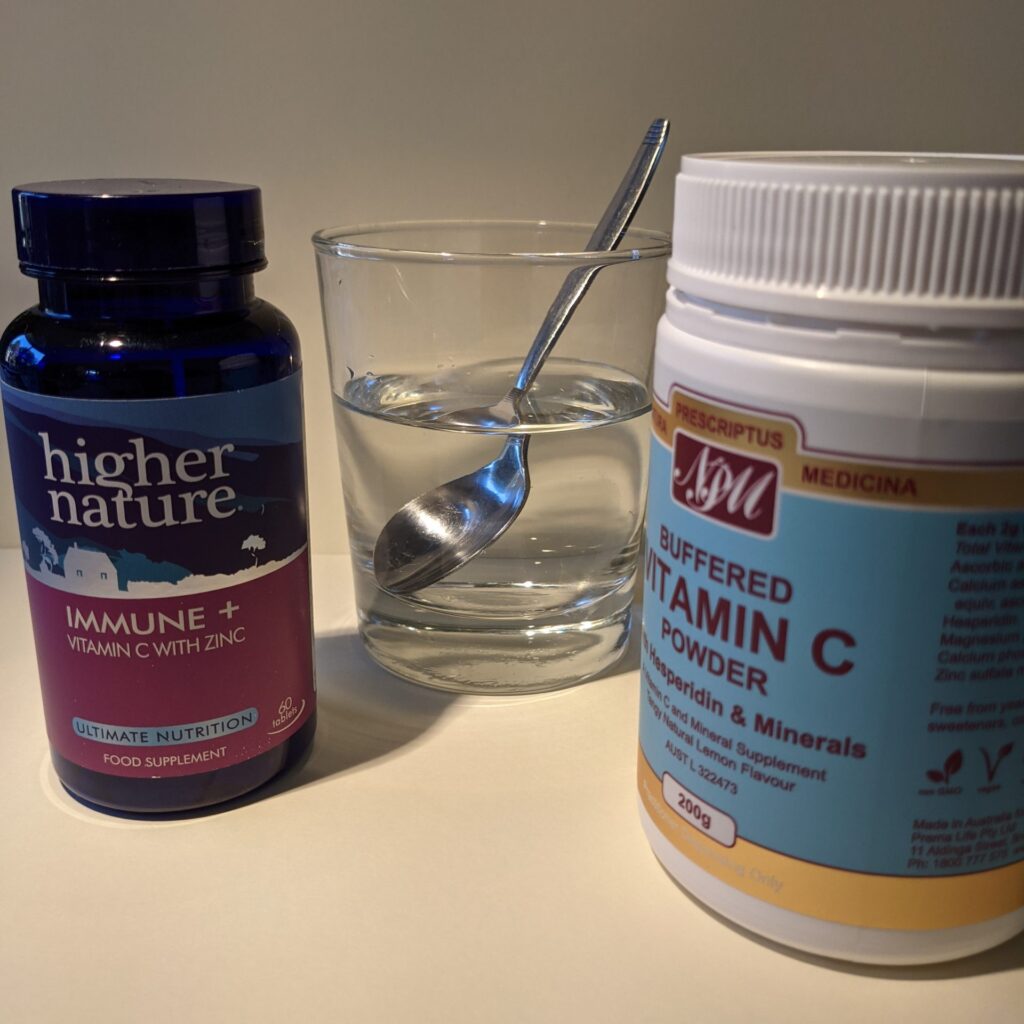
You should all have a pot on your shelf at home – NOW. I favour this one. And no I don’t have shares in the company! Vitamin C being water soluble is removed from the body in the urine, so overdosing is not really possible. A clear sign of saturation is a loose bowel, at which point (obviously) you pull back. But as the body needs more vitamin C when fighting a virus you are unlikely to come to grief. Dr Sarah Myhill in her book Ecological Medicine suggests taking Vitamin C up to bowel tolerance. My personal approach is to go high (maybe 10g +) on day one and then tail off. But we are all different and you can experiment. Some Zinc will not go amiss either – just for a few days. She also favours 2 drops of 12% Lugol’s Iodine in a little water as a gargle (+ inhale the vapour) every hour. I haven’t tried this myself but again you have to have it on your shelf (I now have) so you can try it out when you need it.
And don’t forget rest, drink plenty of fluids and eat light (“starve a cold, starve a fever” says Myhill). The worst thing you can do is try an keep going. At the height of Covid, PM Boris Johnson paid a heavy price (hospitalised) for doing that, though one can sympathise given his role at the time. And, please , lay off the Paracetamol – when fever is suppressed, you hamper the natural immune response.
Can homeopathy help? Yes it can, but only to the extent of boosting the immune reponse, shortening the duration of illness, and reducing the risk of complications. Again you need to have a kit on your shelf and know how to use it. Both Helios and Ainsworth’s Pharmacies have their own versions:
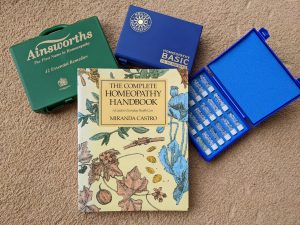
Top remedies are Aconite at the time of onset – if sudden – with fever and restlessness. This is a remedy for the first 36 hours only. The Arsenicum Album picture is also one of restlessness and anxiety with amdesire for company. The is exhaustion and thirst for warm drinks in small amounts. The Bryonia parient on the other hand must lie still, has a very dry mouth (hence is very thirsty – usually for cold drinks), a dry cough and assuredly wants to be left alone, being very irritable. Gelsemium like Bryonia has a slow onset (contra-indicating Aconite for example) but has the classic ‘flu like picture of weakness, achiness and chilliness. The Gelsemium patient also wants to lies still but is not as irritable as the Bryonia type. In Phosphorous there is oppression of the chest and a racking cough, anxiety and a thirst for cold drinks. Consequently it is bit like a mix of Arsenicum and Bryonia.
These are some of the most pertinent remedies in the homeopathic first aid kits. Prescribing may seem a little confusing, but the good news is that the remedies mentioned overlap to some degree, such that some benefit will accrue even if your choice is not perfect.
The point is that we all have to live with nature in which viruses play an important part. You have a symbiotic relationship with viruses and carry many hundreds if not thousands within you. We have to respect the virus and work at our general health. Pasteur’s germ theory only goes so far. His contemporary Bechamp, recognised the compensating importance of ‘le terrain‘ – our general health. Both men were right. Look after your body and it will look after you.
We all know many friends and relations who have had Covid without great incident. Quite possibly you have had Covid yourself. In the past we were used to winter respiratory infections and we need to get used to coping with them again. And we need to relearn how.
The meaning of the word is ‘the agent of something’s down fall’ and this blog considers whether homeopathy is or is not a placebo. Emeritus Professor Edzard Ernst, who prior to his retirement was chair of the Department of Complementary Medicine at Exeter University, took a rather negative stance on complementary medicine and homeopathy in particular.
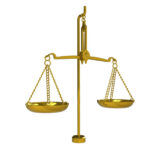
The biblical story of Daniel and King Belshazzar comes to mind (Daniel Chapter 5) where Daniel is summoned to interpret the words Mene, Mene, Tekel, Parsin that mysteriously have been written by a disembodied hand on the palace wall. Daniel reveals the meaning as, ‘God has numbered the days of your kingdom and brought it to an end, you have been weighed in the balances and found wanting!’. Such was the view of Prof. Ernst on homeopathy.
In order to better understand the Professor and his thinking, my second 2023 holiday read was his autobiography A Scientist in Wonderland.
You might find it surprising that I found it rather a good book.
It is not appropriate here to drill down into the detail of the scientific method. Suffice to say that given funding constraints much of the research undertaken was systematic reviews and meta-analyses of previously published work. One problem here is the quantity and quality of the original studies. When it comes to meta-analyses (indeed everything) the quality of the input sets the quality of the output.
You may also be surprised to learn that it was not until 2010 that the Homeopathic Research Institute was established. Its aims are to improve the standards of reseach and its efforts are beginning to yield results. The debate surrounding homeopathy you can find here, and the current evidence here.
Research is an expensive business and mostly in the hands of pharmaceutical companies whose commercial interests lie elsewhere. Their influence is wide, not least in medical schools.
Returning to the book, I have little doubt that Professor Ernst was a caring doctor during his long career. His first job as a physician was in a homeopathic hospital in Munich. He observed that patients got better, but by inference he clearly had suspicions that homeopathy was a placebo effect (from the Latin piacere meaning to please). A suspicion that perhaps he wished to investigate once his career focus moved to reseach work. His appointment to Exeter University brought about that opportunity.
He comes across as a principled man. His career took him across European borders (mostly Germany, Austria and the UK – plus he has a French wife) and his insights into the characteristics of each nation are most interesting. He brought to light some uncomfortably history concerning medical practice during the Nazi era. An unpopular step with some of his colleages who preferred to leave ‘sleeping dogs lie’.
I can concur with his view that there is no such thing as ‘alternative’ medicine – simply good medicine or quackery, though I do not share his conclusions.
Patient safety also is one pillar of his arguments. Could following an alternative path risk the patient’s life? This is a subject I have written on before.
Still, he might well have reflected on the level of iatrogenic disease today (from prescribed medication). The opioid crisis in America is an obvious example. Just recently questions around anti-depressants have hit the news. Dr Malcolm Kendrick writes extensively on statins. And so on..
The jest that in allopathy (orthodox medicine) one dies of the cure; in homeopathy, the disease, comes to mind!
What is really interesting here is our ability to be truly objective. Professor Ernst clearly sought to distance himself from teaching complementary medicine to students in favour of objectivity in research. The importance he attaches to this is very clear. At face value, surely worthy of plaudit?
Yet retired GP and homeopath, Dr Bob Leckridge writes this most pertinent blog. Can anyone ever be truly objective? However hard we try somewhere along the line, self gets in the way.
In another blog, Dr Leckridge pens this (you can read it in full here)
In health care we should hold this knowledge [hazard of too narrow a focus] at the core. We need to start with this individual, unique patient, today, choose the best known, most likely treatment to help them, then follow up to see how it’s worked out for them. Because no treatments produce the same outcomes for everyone, no matter whether a drug is branded “evidence based” or not. Only this individual, unique patient can tell you if the treatment is helping them.
Human beings are not machine like, and health care shouldn’t be factory like. Because every patient is unique and every doctor, nurse and therapist is unique. We need a system built on the value of keeping uniqueness at the core.
Dr Bob Leckridge

Dr Leckridge’s picture of a rose symbolises that uniquess – no two roses are the same. Living things are not like machines. A car stays a car. You, on the other hand, are dynamic; constantly changing. A mysterious combination of the material and immaterial. A data based analytical approach takes you only so far. Valuable for sure – but it is not the whole story.
We may as yet not fully understand the mechanisms of homeopathy but the homeopathic approach has a long heritage. The placebo effect is real, but insufficiently so to justify two hundred years of effective homeopathic practice throughout many countries globally.
There is a little accronym TEETH (Tried Everything Else, Try Homeopathy). That homeopathy is often the last resort and proves beneficial is a point to reflect upon.
Homeopathy may be the ‘aunt sally’ of the medical world, but placebo it is not.
Somewhere in this realm is Professor Ernst’s nemesis.
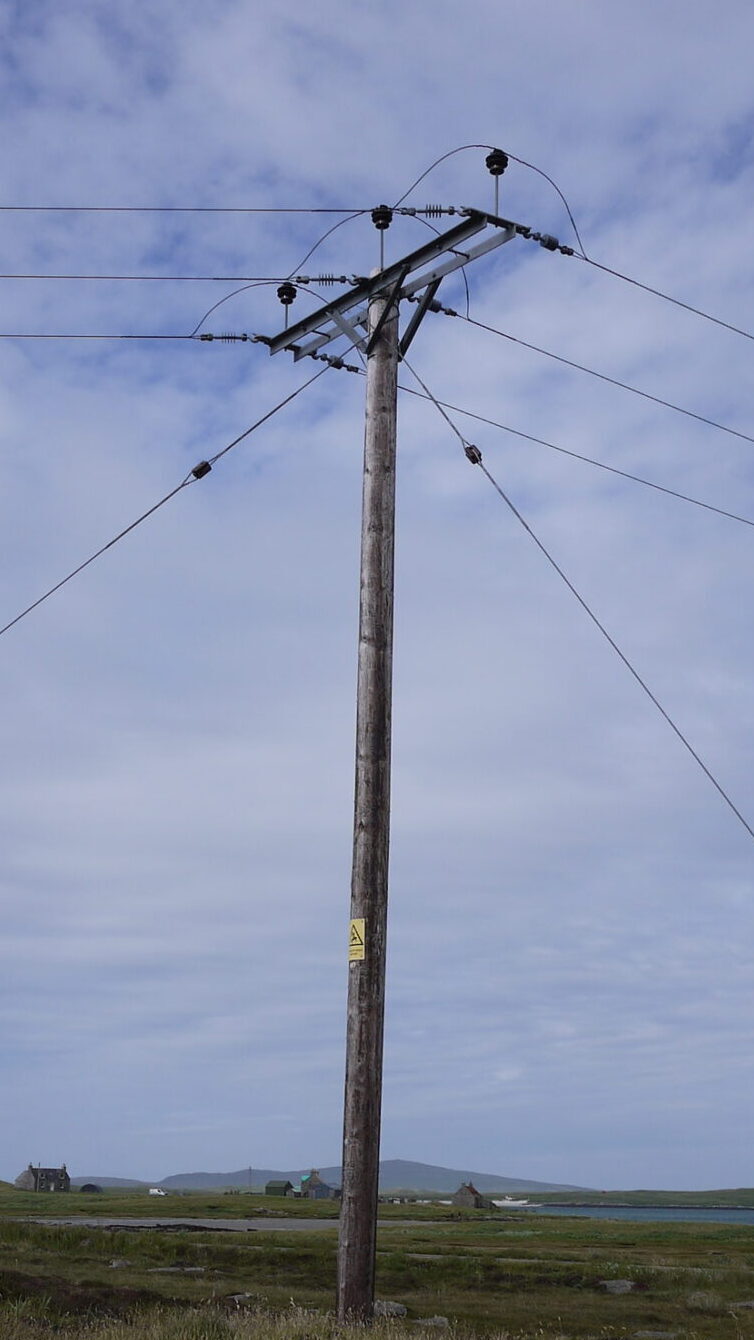
My wife and I just spent a week touring the Western Isles. I didn’t take this photo as a substitute for a tree (its a blowy place in winter and the soil is shallow, so trees are few) but it got me thinking about power and the messages we receive.
Holidays give you time to catch up on some reading. Sad perhaps, but the book I first chose on my e-reader was by Dr Suzanne Humphries and Roman Bystrianyk, titled Dissolving Illusions, Disease Vaccines and the Forgotten History. It was rather good.
Now I have to tread carefully here, as the Society of Homeopaths is precise on its guidance to members.
“The Society does not permit RSHoms to provide advice on, or participate in a patient’s decisions regarding vaccination. In line with current UK law, they may signpost patients to information on vaccination from reliable sources, including the NHS, so that they can make a fully informed decision. Homeopaths will support patients in their decision.”
Source – Society of Homeopaths Website
So, in line with the above, I simply draw to your attention some of the themes in the book which I found interesting, and hope you might also.
The opening chapters consider the nature of transmissible disease and the epidemics that often result. It is a remarkable fact that God, Nature, Evolution (you may choose one or more) has gifted us with a remarkable physiological system, that by means of innate and adaptive immune response protects us from innumerable bacteria and viruses. Actually our bodies contain trillions of these and it is only a very few that bring us to grief.
It should than come as no surprise that a healthy nourished body fights infection best. I have written on this general topic before. Nothing controversial here, I hope.
These opening chapters describe the lives of the poor in Dickensian times and up until the early years of the 20th century. This short passage serves as a brief summary:
‘Among the labouring classes, life expectation remained low – little more than thirty years – and the 1930s photographs show working people looking old by their thirties abnd forties, as poor nutrition, illness,bad living conditions and gross overwork took their toll.’
Humphries, Suzanne; Bystianyk, Roman: Dissolving illusions (p32) Kindle Editions
‘Bad living conditions‘, is rather an understatement: overcrowding, foul air, polluted water, vermin and running sewage etc. The silver vinaigrette was of doubtful value
By chance we passed through a cemetery in North Uist, and it is remarkable how many lived to a good age in a rural setting in contrast to the industrial cities. You might care to wander through a churchyard in the New Forest, a very rural part a century of more ago, and see if you come to the same conclusion.
The simple fact is that by improving nutrition and living standards, lifespan increased dramatically during the twentieth century.
The ‘illusion’ referred to in the title of the book is the extent to which advances in health are attributed to advances in medical therapeutics. That is not to deny the advances in medicine and surgery during the 20th century, just that they tend to take too much of the credit.
The second half of the book focuses on the principal diseases, smallpox, diphtheria, polio, whooping cough, measles and so on. The general theme was that each had declined significantly before medical intervention (usually vaccine).
As a Glaswegian this statistic struck me:
‘Before the general nutrition status of European children reached the high level it is today, measles infection was something to be feared… measles accounted for 11% of all deaths in Glasgow in the years 1807-1812.‘
Humphries, Suzanne; Bystrianyk, Roman. Dissolving Illusions (pp 328-329). 2013 Kindle Edition
My generation caught measles as a matter of course, and with some sensible nursing from Mum, we survived unscathed.
In the UK measles vaccination commenced in 1968 and the chart below is quite interesting. I will leave you to draw your own conclusions.
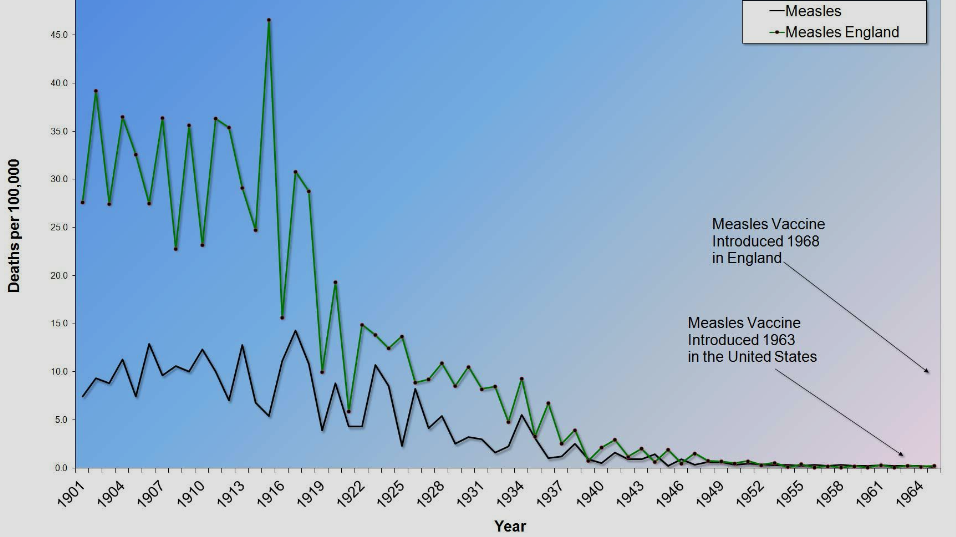
Considering the theme that underlies all the diseases covered in the book, the lines below from a book by Daniel M Davies, Professor of Immunology at Manchester University came to mind:
‘We are at the dawn of a new health revolution. But the elephant in the room is global poverty. Nearly half the world lives on less than $2 a day, and the economics of making and providing new medicines is another kind of tragedy…..Though it deals with matters of life and death, the pharmaceutical industry is a business not a charity and when deciding research priorities, the potential for financial gain is a critical factor if not the decisive factor…’ Davis D, Beautiful Cure (p195), Bodley Head, 2018
So is it new medicines we really need, or better living conditions? Returning to Humphries and Brystianyk:
‘The Bill and Melinda Gates Foundation will donate $10 billion over the next decade to research new vaccines and bring them to the world’s poorest countries… they said the money will produce higher immunisation rates and aims to make sure that 90 percent of children are immunised against dangerous diseases such as diarrhoea and pneumonia in poorer nations.
“We must make this the decade of vaccines,” Bill Gates said in a statement. “Innovation will make it possible to save more children than ever before”.
Perhaps a $10 billion decade of sustainable farming, nutrition, and sanitation would have a long-lasting impact on saving the children under discussion?’
Humphries, S; Bystrianyk, R. Dissolving Illusions (pp. 290-291). Kindle Edition
What do you think?
Vaccines using attenuated / live viruses yield a better immune response that those using inactivated material. In technical terminology they are more antigenic.
The feared disease of my generation was polio, and you’d think it would be a heroic story (I did too). In fact it is complex, and you’ll have to read the book if you wish to know more. Suffice to say that inadequacies in diagnostics, treatment, vaccine development, and environmental factors all underminine innate immunity. Add to this the media generated climate of fear mean that polio continues to cast its shadow. A fear, the authors argue, that is disproportionate to risk.
The polio vaccine story is interesting.
The polio vaccine comes in two forms. The live / attenuated Sabin vaccine – (that given orally on a sugar lump in my day) and inactivated vaccine (Salk), as used in the DTP jab – the P being polio. The former (Sabin) being ‘live’ – as mentioned – is more antigenic.
The problem with the ‘live attenuated’ Sabin virus is that it can be excreted in faeces. Latterly this proved to be a more significant cause of polio outbreaks than the ‘wild’ virus (vaccine-derived-poliovirus or VDP).
The vaccine used in the UK today is the inactivated version for that reason.
In some parts of the world the live / attenuated form is still used. The source of the polio virus recently identified at a sewage treatment plant in London is thought to be India or Pakistan. Two countries that still use the live / attenuated vaccine.
(Somewhat similarly, the book tells the tradgedy caused by inadequate viral inactivation in the original Salk vaccine, which resulted in significant viral spread – here is a paper on the story The Cutter Incident. Though the currently used vaccine is a version of the Salk type it has obviously been modified to ensure no repeat of the Cutter debacle.)
Moving onward…
I am a bit of a fan of fellow Scot, Dr Malcolm Kendrick, GP and author. As an insider, he can better observe the medical system than most.
Dr Kendrick is the author of an excellent book titled Doctoring Data. In this book he shows you how numbers get manipulated to justify decisions.
His particular interest is heart disease, and he questions the high cholesterol hypothesis in cardio-vascular disease. Consequently, he challenges the current enthusiam for ‘statins’ – a profitable business.
He has a new book on the subject.
There is one other topic which he observes to be off limits: vaccination. Just in the last week or so he penned a very interesting blog titled Vaccines – how did they come about?
And lo, homeopathy gets a mention…
‘Homeopathy is mocked’.
‘Vaccination is venerated’.
Yet, as he elucidates they have a common ancestry. How interesting.
The original use of cowpox virus to protect against smallpox actually follows the homeopathic principle of “like cures like” (law of similars). Today, the term vaccination has taken on other meanings.
Back to Humphries and Bystrainyk for clarification:
‘Vaccination: From vacca, the Latin word for cow: Inoculation of cowpox virus (orthopox vaccinia virus) with the intention of protecting against smallpox virus. Also known as cowpoxing.
Today the term has been used to describe many other types of inoculations: A preparation of a weakened or killed pathogen, such as a bacterium or a virus, or of a portion of the pathogen’s structure that, upon administration, stimulates antibody production or humoral immunity against the pathogen.‘
Humphries S; Bystrianyk R, Dissolving Illusions (p22). Kindle Edition
As an aside, the Covid mRNA “vaccines” are further removed still from Jenner’s “vaccine” concept. Ne’er a cow in sight.
I return to the strange photo at the top of this blog, which shows a power line.
As Prof. Davis noted the pharmaceutical industry is a business and power and money as we all know are close bedfellows.
Alas there is not a lot of transparency (nor science) when power and money are involved. The issue reaches well beyond the matter of vaccines as comedian Russell Brand entertainingly explains on YouTube here.
Next time I’ll return to homeopathy with a reflection on the second book I read on holiday. Is homeopathy placebo or not?
By the way, if the subject of childhood vaccination interests you, I commend Dr Richard Halvorsen’s well researched book.
Finally, to do justice to the people of the Western Isles, there is rather more to see than power lines. Here is Tarbert (Harris) on a beautiful sunny day.

I was rather struck by these colourful beach huts (and the price of them!) which brings me to write again about Homeopathy and nutrition.

Last week I was in Chelmsford to attend the Allen College of Homeopathy Summer Conference to learn from a master prescriber, Dr Subrata Banerjea.
Dr Subrata Banerjea who runs the Allen College is the fourth generation in his family to practice homoepathy and his son, who now runs the Calcutta Clinic the fifth. Quite a dynasty.
I understand that in India today there are some 300 thousand medically qualified homeopaths. Interesting, given the tendency to dismiss homeopathy these days in the UK.
On the day off, I visited Frinton-on-sea, and took the picture. Most of the huts which stretch for miles are not triple or quadruple deckers (pleased to say), but it makes for a fun picture. Frinton is one stop up the line from the better known Clacton-on-sea. There was a musical hall quip “Harwich for the Continent, Frinton for the incontinent” which rather betrays the average age of the residents!
Seeing the colours brought to mind the core subject of this blog; not just homeopathy but also nutrition and its importance, which I will come to in a moment.
Dr Samuel Hahnemann (he who set down the principles of homeopathic medicine in the 19th Century) made clear in his seminal work, The Organon of Medicine, is that healthy living conditions – fresh air, fresh food, clean water are the key to good health. First address the fundamentals!
As I write, I observe a flight of ants from a nest under a flagstone in the garden. Interesting. Then my wife returns from a Rainbow Guide group she leads and reports flying ants around the WI Hall where they meet. Interesting again. Now a reasonable assumption is that they are not the same ants..so how come ants decide to fly today at 6pm? How does the message go out? What form is the message? I guess we don’t really know.
The sun rose and set for millenia without explanation, but that it did so was sufficent for mankind to sow and reap.
My point is that there is a lot we don’t really know. As best we can judge, homeopathic medicines communicate a message also, as yet don’t know precisely how.
Without question homeopathic medicines work differently to conventional medicines – as I said last month, the domain of action is more bio-physics than bio-chemistry. So the work goes on…
The challenge is to understand how homeopathy works – which rather suggests that we are clear on how conventional medicines work. This is not always correct, despite the billions spent on pharmaceutical research.
However, there is now a Homeopathy Research Institute based in Bern, Switzerland and last month was their annual conference also. Although funding is modest, Institute Director, Dr Alex Tournier, in his closing remarks, noted the increasing good quality evidence from many countries.
Even the topic of nutrition causes much discussion. The full process of digestion and assimilation is not wholly understood. Is it just about carbohydrates, protein, minerals and vitamins? Suffice to say there are sound principles which we should try and follow.
Just look at this picture taken from just round the corner from where I live. Quite stunning – so much so that I got off my bicycle and reached for the camera on my phone.
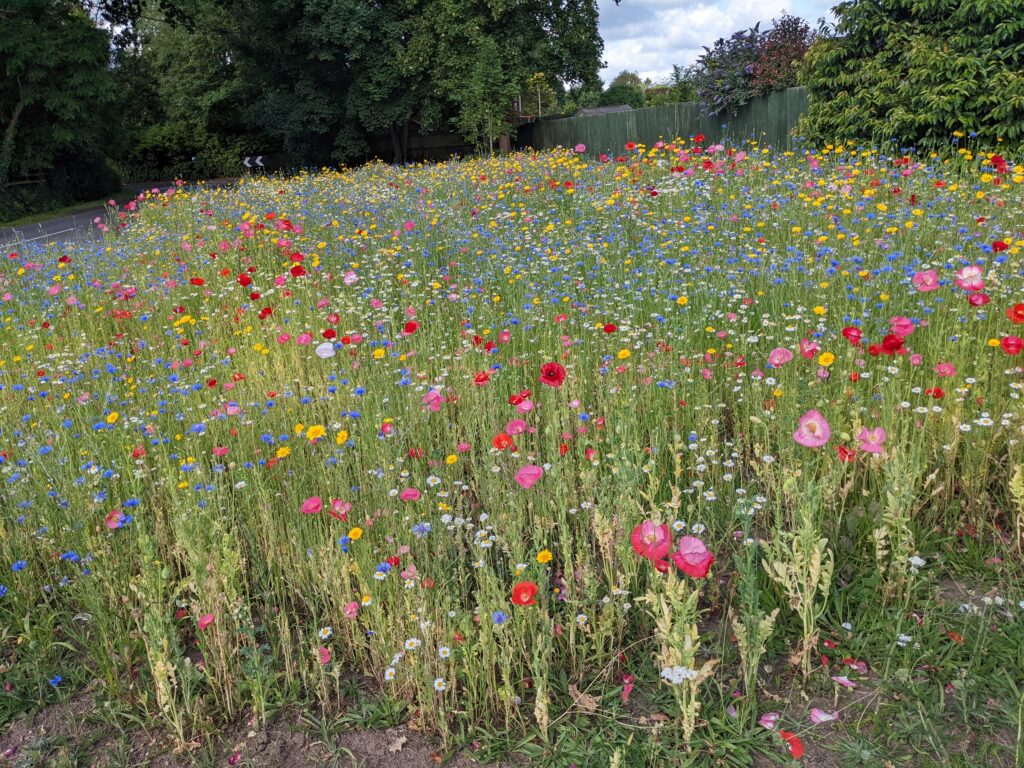
Colours tell us something and it is well known today that different colours in our food impart different benefits. The flavanoids are found in fruits and vegetables and are well known to have anti inflammatory properties. Herbs and plants have been used to treat disease for many centuries. It is only recently that synthetic drugs (often synthesised from plants) have existed. All well and good (sometimes..) for the treatment of disease, but less ideal for prevention. And as we all know, prevention is better than cure.
Dr Paul Clayton in his book Health Defence notes that the NHS “is really an ‘illness service’ – treatment after things go wrong”. This is costly – according to Dr Clayton £750 (in 2000) for every man, woman and child. Personally, I doubt this is affordable in the long term.
Alliance for Natural Health International (ANH intl) and I see they have a book on dietary matters. The chart below also comes from ANH Intl. and make its point colourfully (if you forgive the pun). So add some colour to your diet, its a good investment in your future.
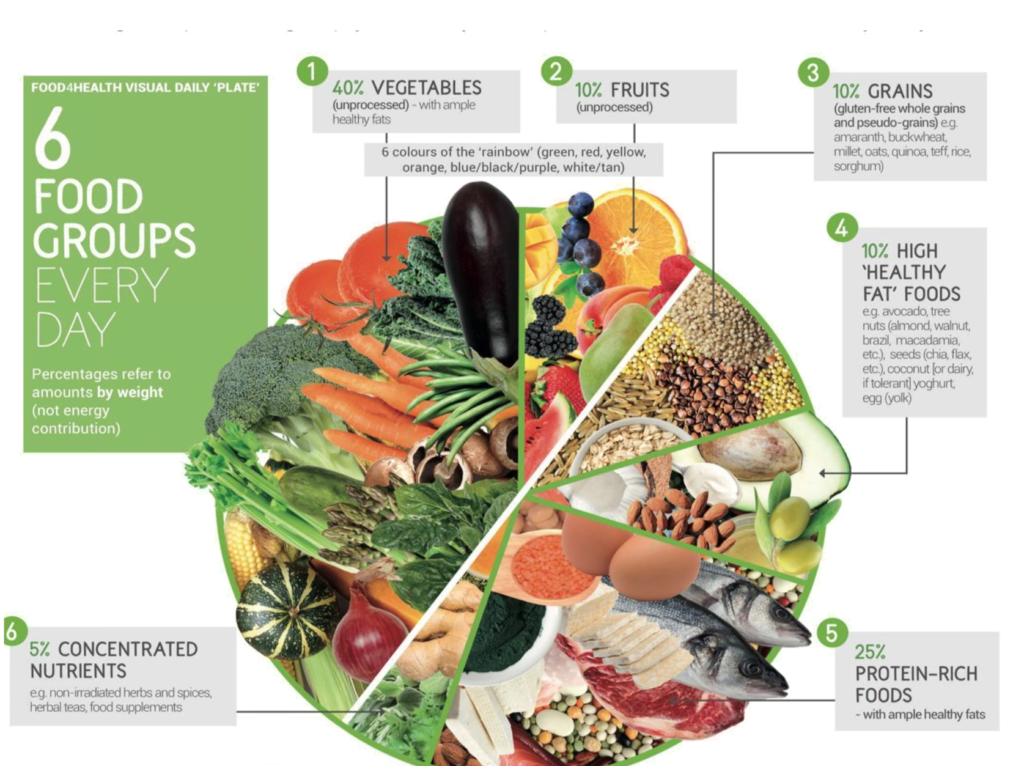
This year has been particularly good for azaleas and rhododendrons. The photos here were taken in Inchmarlo near Aberdeen just a few weeks ago. Exbury gardens locally are a similar example.
The colours brought to mind advice for an anti-inflammatory diet given at a recent Pharma Nord presentation I attended. Here is the key slide:

“Let food be thy medicine..” are words attributed to the Greek physician Hippocrates (460 to 375 B.C.E) – he of Hippocratic oath fame. Whether or not he actually penned these words is open to question, but he surely recognised the value of diet in health as is nicely summarised here.
At any rate we should not underestimate the importance of diet, a subject I have touched on before.
Here is a nice website that allows you to explore the nutritional values of common foods, should you be interested.
Unfortunately it seems that the micronutrient content of our soils is not what it once was, though there are counter arguments. This short article from Scientific American makes the point. Selenium is but one of the micronutrients that are in short supply.
In the USA – home of ‘fast food’ – there is also a counter culture, and the Weston A Price Foundation is a well established example. You could spend quite a while on their website.
Simply put, there is a food chain from the soil via plants and animals (vegeterians excused) to our own tissues. Important? Well, obviously.
The homeopathic pharmacy is built on the energetic qualities or essence of the natural world.
Around two-thirds of homeopathic remedies are potentised ultra dilutions of plants. Some from plants we eat and some from plants that are poisonous (but no longer so when prepared accouding to the homeopathic pharmacopaeia).
The emerging evidence is that the nutritional value of food extends beyond the biochemistry into what might be described as bio-physics. That such view challenges conventional science is not in doubt…and much argument will result.
Be that as it may, we’d do well in the meantime to look after the soil and in so doing it will look after us.
It was concerning to read about the quantity of pharma drugs in rivers today. This article considers the consequences and alternatives.

Back in February The Week published the following short article:
Pharmaceutical pollution is contaminating the rivers on every continent, a major study has shown. Scientists at the University of York measured the levels of 61 active pharmaceutical ingredients (APIs) in 258 rivers around the world, including the Thames and the Amazon.
Just two areas had unpolluted waters: Iceland and a part of Venezuala whose indigenous inhabitants don’t use modern medicine. The most common APIs were an anti-epileptic drug called carbamazine and the diabetes drug Metformin, along with paracetamol, antibiotics and caffeine.
Potentially toxic levels of drugs were in a quarter of the sites, and the highest being in low-to-middle income countries such as India and Nigeria – possibly because their populations have encough money to by drugs but may live in areas without good sewage infrastructure.
The most contaminated site in the UK was the River Clyde in Glasgow.
The study, published in the journal Procedings of the National Academy of Sciences, warned that pharmaceutical pollution poses a risk to wildlife, and could also contribute more to antimicrobial resistance in humans.
The Week 26th Feb 2022
Previously on a BBC science programme I heard that the equivalent of 200 pills of Metformin pass under the bridges of the Thames every hour. Even the apparently pristine River Dee in Royal Deeside carries a significant pharmaceutical burden as this report shows. Hopefully the famous Deeside Water – highly regarded for its purity – is sourced well upstream!
The NHS Health Survey for England 2016 states that nearly half of adults had taken one prescribed medicine in the last week and 24 percent had taken three or more. The total cost at list price of prescriptions dispensed in the community in 2016 was just short of £10 billion. It is not an improving situation.
None doubt the value of medicines, but health impact both on the individual and the enviromnment of long-term use is a matter worthy of discussion.
For the first time since school days I read again Aldous Huxley’s dystopian novel Brave New World written in the 1930s. His vision was one where the highs and lows of human existence were under the control of a world state. With remarkable prescience Huxley foresaw the path we are on today. Elsewhere he remarked, “Medical science has made such tremendous progress that there is hardly a healthy human left”. I dare say there is a degree of overstatement here, but he had a point nonetheless.
It is a subject I indirectly blogged on previously
What is health? That is the question. During the first lockdown of the pandemic I cycled out into the New Forest and visited a couple of Churchyards. I was struck by the longevity even in an age of no medical care.
It made me think about the late Jan de Vries, a remarkable naturopath who ran a clinic on the west coast of Scotland until his death in 2015. He wrote many books amongst them 10 Golden Rules for Good Health. Attention to these basic principles would do much to reduce the burden on the NHS not to mention the individual.
I do not underestimate the challenge: a very rural 19th century New Forest is very different from modern city life.
Homeopathy, osteopathy, naturopathy and other forms of so-called Complementary and Alternative Medicine (CAM) all seek to maintain the human organism in balance.
They are not always quick fixes. The saying “a stich in time saves nine” is very true – the longer things are our of balance the longer it takes to correct.
Sadly, CAM has been marginalised in the health service. Some argue that such approaches do not work and waste money. Yet, the long term cost of the current medical model is problematic.
Time for a rethink?
So what are Homeopathic remedies (medicines) and how do they differ from what we now consider to be orthodox medicines.
I had the dubious pleasure of a FB encounter with a person who was under the illusion that the homeopathic preparation Mercurius was a poison. Mercury – such as can be found in a traditional thermometer surely is a poison – hence the term “mad as a hatter”.
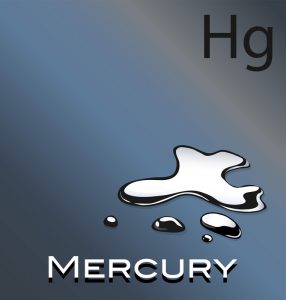
The origin of that saying can be found here. Mercury is the only metal that is liquid at normal atmospheric conditions. It was used in medicine for many years as this article summarises, and toxic is surely is. That dental amalgam still contains mercury to this day is perhaps a matter of concern.
The preparation of homeopathic medicines (potentisation) – a process of serial dilution with agitation at each step (succussion) – was developed by Hahnemann in order to eliminate any poisonous hazard yet maintain therapeutic benefit. This enabled many substances that were poisonous – be it plants, minerals or animal venom – to be safely used as medicines.
The bottom line is that you cannot poison someone with a homeopathic medicine.
But poisons, potentised homeopathically make some of the best medicines – see my earlier blog
The controversy in homeopathy is that the level of dilution is so great that no molecule of the original substance remains. From school days you may remember Avogadro’s number which defines the particles in a quantity known as a “mole”. Once dilutions exceed this number no atom of the original substance remains. Ultra-dilution is a key concept in homeopathy.
If you believe that all medicines must be material doses, then you will insist that all homeopathic medicines are placebo. The usual quip is “there is nothing in it” or “its a drop in the ocean”!
Fair enough, but two centuries of experience suggest otherwise.
You might have come across the concept of “hormesis”?
Hormesis is defined by toxicologists to describe a biphasic dose response to an environmental agent with a low-dose stimulation showing beneficial effects and a high-dose stimulation showing inhibitory or toxic effects.
from: The Science of Hormesis in Health and Longevity
Maybe hormesis extends to lower doses than we think?
Today we sit in our homes bombarded by information. For your grand or great-grand parents there came radio, then television and now all that feeds your mobile phones. This is “information” and that is most likely what homeopathic remedies contain also. The homeopathic remedy “informs”.
Human beings are many things. I have written on this before. For sure we are complex chemistry sets but also electromagnetic. Here is a little bit of pioneering science – a sort of electronic homeopathy.
So what of Mercurius solubilis – this patient is hot when it is cold and vice versa – like the mercury thermometer they are sensitive to temperature. It is useful for nasty sore throats, mouth ulcers, feverish colds with lots of catarrh and more besides.
Homeopathy means “like” “suffering”. If the Mercurius “picture” matches your “symptoms” it will speed your recovery.
But the homeopathic remedy Mercury will never, ever, poison you!
I was once asked if homeopaths make a diagnosis. A good question and I fear my answer was not as concise as it might have been.
The simple answer is that by law only your doctor or specialist can make a formal diagnosis. This is with good reason, because he / she can arrange blood tests, X-rays or refer you for further investigation. This is outside the capability of the professional lay homeopath.
There are medically qualified (doctor) homeopaths who needless to say have a foot in both camps.
In fact, it is fairly rare for someone to seek a homeopathic consultation before they have seen their GP or specialist. For one thing the NHS is a free service, so your doctor is the obvious first port of call. That said, complementary therapists learn about “Red Flags”. These are warning signs indicating that further investigation by your GP is needed to rule out any risk of a serious underlying condition.
Here is a picture of the cover of an excellent little book that I have on my shelf:

In the UK medical records are by and large held centrally, but this is not the case elsewhere. When I sat in on homeopathic consultations in Calcutta, it was normal for patients to carry with them the documentation from whatever investigations they had undergone. This is quite common in many countries. All this was very useful to the homeopathic doctor (in India there are two equivalent paths in medicine – orthodox western and homeopathic). Needless to say your diagnoses from the NHS are equally of value to the professional lay homeopath here.
Diagnostic tests indicate what is going on: what is as it should be, and what is not. They are not always fullproof. Results can range from the possible to the definite. Referral for further investigation may be necessary.
Accuracy and speed in diagnosis is a big topic in academic circles should you care to look into the matter. Unsurprisingly, artificial intelligence is the new frontier!
An important outcome from diagnosis is the likely trajectory of the condition. Will it get worse, stay the same or get better with or without treatment? Hopefully it is not “how long have I got doc?” as the sit-coms or “soaps” sometimes have it, but fair to say none of us live for ever!
The above would all seem positive and in many ways it is, but there is a hazard in diagnosing a condition, which usually means giving it a name. Thus people will say I have X or I am Y. The problem here is that once you have been put in a box with a classifcation X or Y it is easy to be resigned to the label. It becomes part of you.
In homeopathy disease symptoms have a wider meaning. No two persons with the same diagnosed condition will be treated in the same way. Dr James Tyler Kent one of the most notable American Homeopaths the early part of the twentieth century wrote this:
Most of the conditions of the human economy that are called diseases in the books are not diseases, but the results of disease. To call a group of symptoms a disease of one part, and another group of symptoms a disease of another part, is a great heresy….. Organic disease is the result of disease
Lectures in Homeopathic Philosophy, Lecture IX Dr James Tyler Kent
Ok, the language is old fashioned, but what he is saying is that your true dis-ease is something that is prior to the symptoms that cause you make an appointment with your doctor. I touched on this subject before.
So the question is what underlies the child diagnosed as ADHD or a skin condition, or an adult with rheumatic pains or digestive problems or whatever?
Sometime that cause is apparent from orthodox investigation, but often not. The long term management of the symptoms is the best that can be done. In contrast, homeopathy looks at patterns in health, mental physical and emotional. It is sideways look that can find a solution to an intransigent problem. It is not boxed-in by labels.
This month I wish to share with you two homeopathic remedies for fever that are particularly helpful in children with fever – a common state of affairs
Last time I introduced the topic of homeopathy as first aid in the home, and the value of having a small first aid kit, and without doubt these two remedies will be there.
Fever is not a bad thing. Every symptom has a purpose; illness has a purpose. And the purpose of a fever is to fight infection – it is a natural response of the immune system. So try and not suppress fever with paracetamol containing over-the-counter medicines.
The latest NHS guidance is here. And yes, the use of paracetamol is permitted if the child is in distress but you might try some homeopathic first aid as an alternative first.
They work for adults too.
The two remedies are Aconite and Belladonna. Both have their origin in poisonous plants, but remember the potentised homeopathic remedy is an ultra-dilution and non toxic. Explanation here.


The challenge in homeopathy is to recognise the different characteristics in your child and to match them with the correspondingly remedy picture. There are fevers and there are fevers!
Here are some basic pointers for these two homeopathic medicines with two nice cartoon images from the book Homeopathic Remedy Pictures by Vicki Matheson and Frans Kusse.
The aconite child is fearful and anxious and doesn’t want to be touched. The fever is dry and comes on quickly within a few hours and is worse between 9 and 11pm. Coldness and heat alternate. The child is chilly and wants to be covered. He or she is thirsty. It is a good remedy for shock also.
It is a short acting remedy – if the fever persists much beyond a day then another remedy should be chosen.
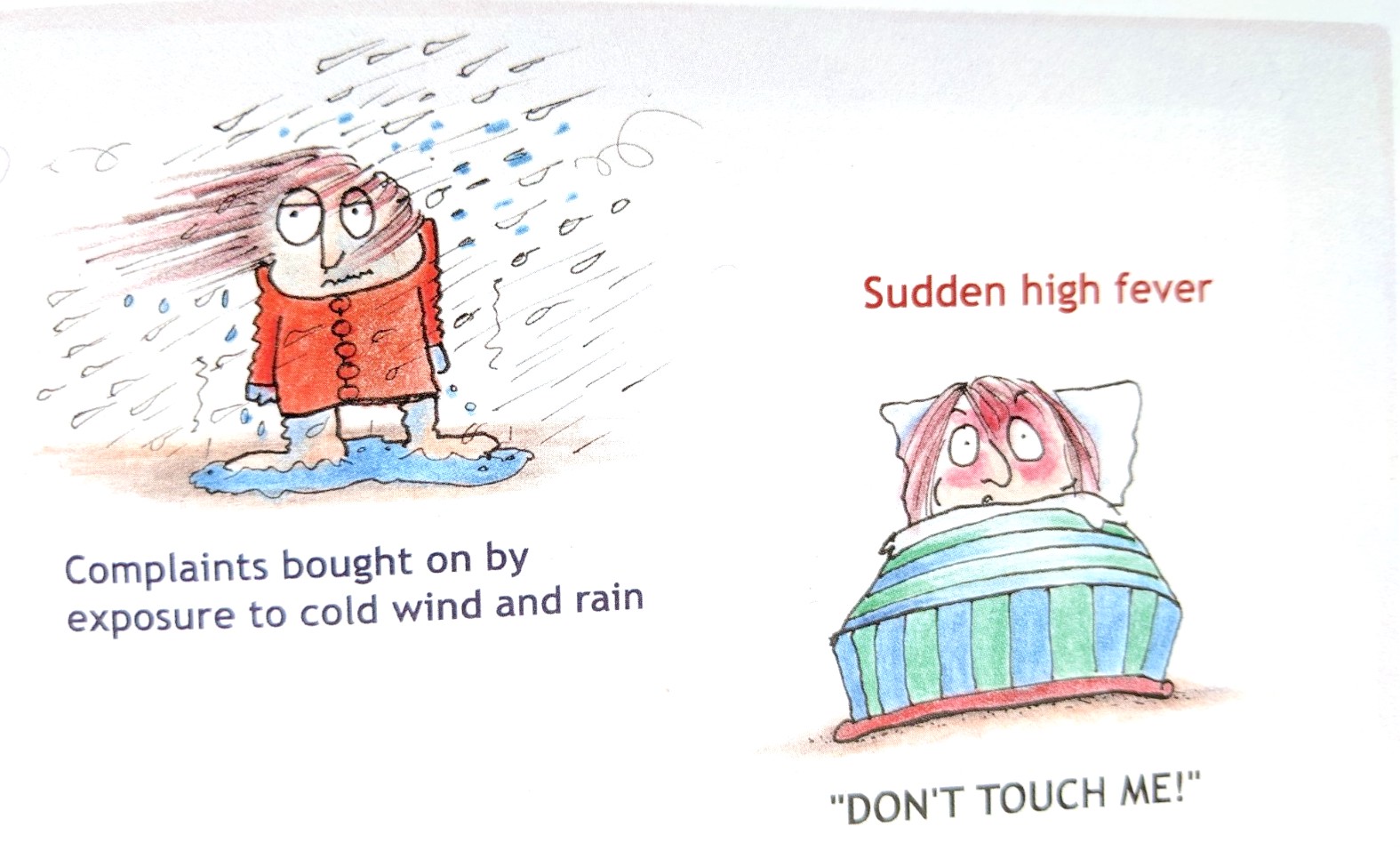
The belladonna child also comes down with a sudden fever but there is a slightly slower onset than with the aconite patient. This child is burning hot and hypersensitive. There is violence and agresssion rather than fear. The pupils may be dilated – in contrast to aconite (constricted). The fever can be worse at 3pm or 3am. The patient may be delirious. Despite the heat, the child may not be thirsty. It is a useful remedy for sunstroke – the pounding head and red face gives you the picture. Dr RAF Jack also had this remedy as No1 for earache.
Belladonna is a somewhat longer acting remedy – about 72 hours.
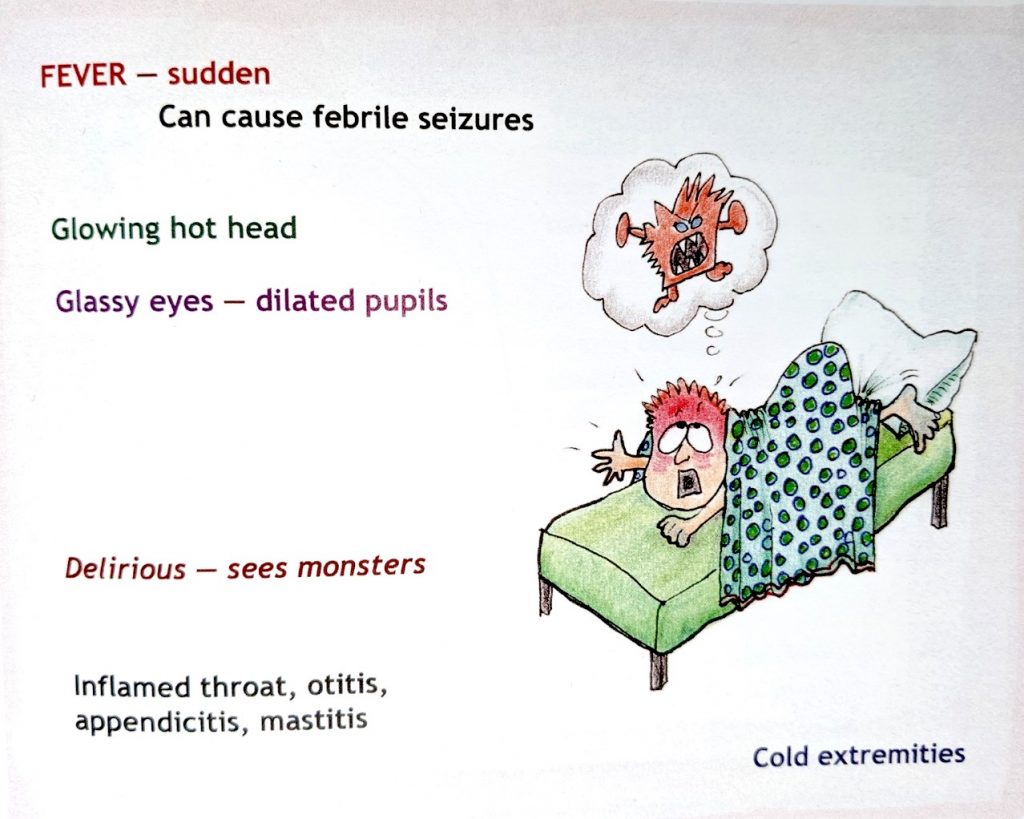
Just a small introduction, but it might get you some sleep…!
Do you have a first aid kit of homeopathic remedies?
I dare say that those of you with young children have spent some time at the bedside when they are sick.
What to do? Give TLC and Calpol?
But have you thought about homeopathy as an alternative?
The first thing you will need is a small first aid kit of homeopathic remedies. Forearmed is forewarned as they say.
These are shown in the picture and available from homeopathic pharmacies such as Helios or Ainsworths
You cannot phone a pharmacy in the middle of the night or Sunday (which according to some unwritten law is of course when your child takes poorly!).
Because there are many remedies, homeopathy can seem complicated. For First Aid, things can be kept simple.

You know when your child is sick because they are out of sorts.
Years ago I remember taking our young son to Disneyworld. He didn’t seem as excited as you might expect. Next day, up come the spots – chicken pox!
This demonstrates a pattern in childhood illness (ssh..Covid too): a period of incubation with no symptoms, then recognisable symptoms and finally convalescence. Most childhood ailments are like that.
However, do see your GP if your child is getting sicker – first aid, homeopathic or otherwise, is not for everything. Yet, even here homeopathic first aid can buy time whilst you seek help.
Homeopaths speak of a vital or life force. It is beyond the physical (meta-physical) and I wrote an earlier blog on this. In brief, it keeps us alive.
Children have loads of energy – you may have noticed – because their vitality is so strong. However, their immune systems have a lot of learning to do in order to cope with the world at large.
Homeopathy informs the vital force; gives it a helping nudge; educates.
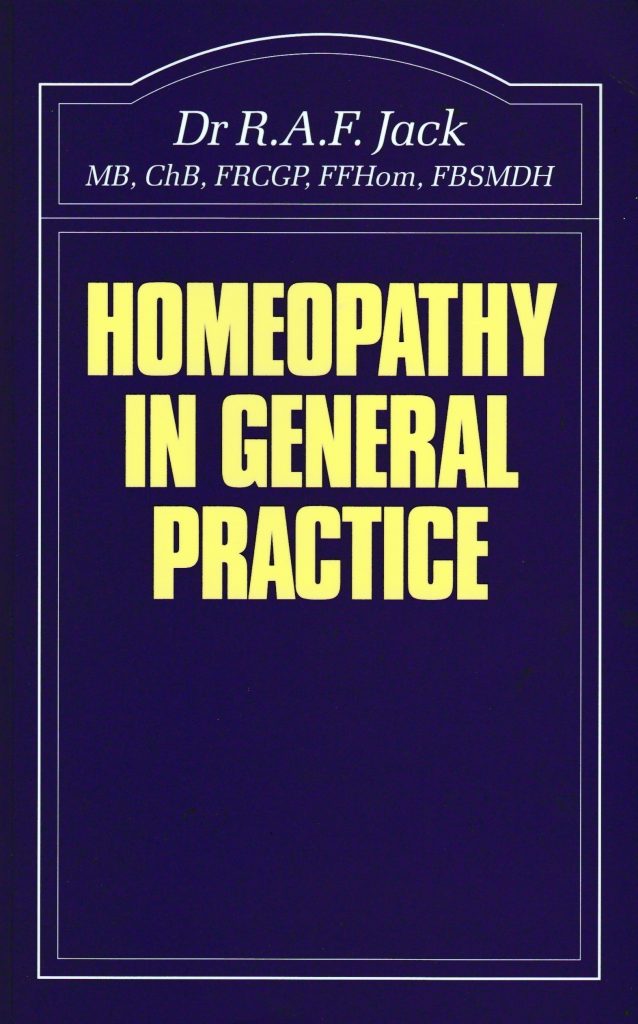
On my shelf is this little book from the pen of the late and wonderfully initialled Dr RAF Jack. He was a GP in the Midlands in the latter half of the twentieth century.
Dr Jack supplied every family with young children on his list with a good starter first aid kit of just four homeopathic remedies:
Aconite, Belladonna, Ipecachuana and Chamomilla
He explained five features – sufficient to get the mother’s confidence:
(point 5 may may puzzle you? Quantity is not important in homeopathy, but repetition of dosing is. By analogy, imagine 2 people ask you to turn left at the same time, you will turn left once; but if the instruction is separated you will turn left twice – too many doses risks getting you in a spin!)
Let’s look at one remedy Chamomilla. That is the herb Camomile prepared homeopathically.
This is a remedy for PAIN, unbearable pain often associated with anger. Famously useful for the teething child with hot and red cheeks or one hot and red and the other pale and cold. The child cannot be comforted, asking for a toy and then hurling it across the room.
Here is a nice little image from Homeopathic Remedy Pictures:

A dose is usually one sugar pill, but as said above, quantity is not that important (except on your wallet). For a baby you can put a couple of pills in a small amount (5cm in a tumbler) of boiled cooled water – stir well and give two teaspoons.
Repitition depends on the seriousness. Maybe every 10-15 minutes to start with, but reduce to half hourly or longer if the symptoms start to improve. Do not continue to give the remedy once there is clear sign of improvement.
And if you see no improvement after a couple of hours, stop, it is the wrong remedy.
Next time we will look at Aconite and Belladonna – swords to ploughshares…
Prompted by the name on the door lintel in the photograph – this blog considers the role of the homeopath.
“Double, double toil and trouble; Fire burn and cauldron bubble. Fillet of a fenny snake, In the cauldron boil and bake; eye of newt and toe of frog, Wool of bat and tongue of dog…”
Shakespeare’s Macbeth Act IV
Well you get the idea….
I was intrigued – maybe a little taken aback – to read a recent editorial in The NewHomeopath (the Journal of the Society of Homeopaths) that homeopaths were the new witches!
True enough, the gender of the Homeopath today is most likely to be female; the mix for must be 20:1 in favour of women. Yet, none I have met would meet the picture of a witch.
Permit me a brief digression here. Bring to mind the stereotypical image of a witch and compare it to the male equivalent, the wizard. I suggest that one is artistically treated rather more favourably than the other, which might tell you something.
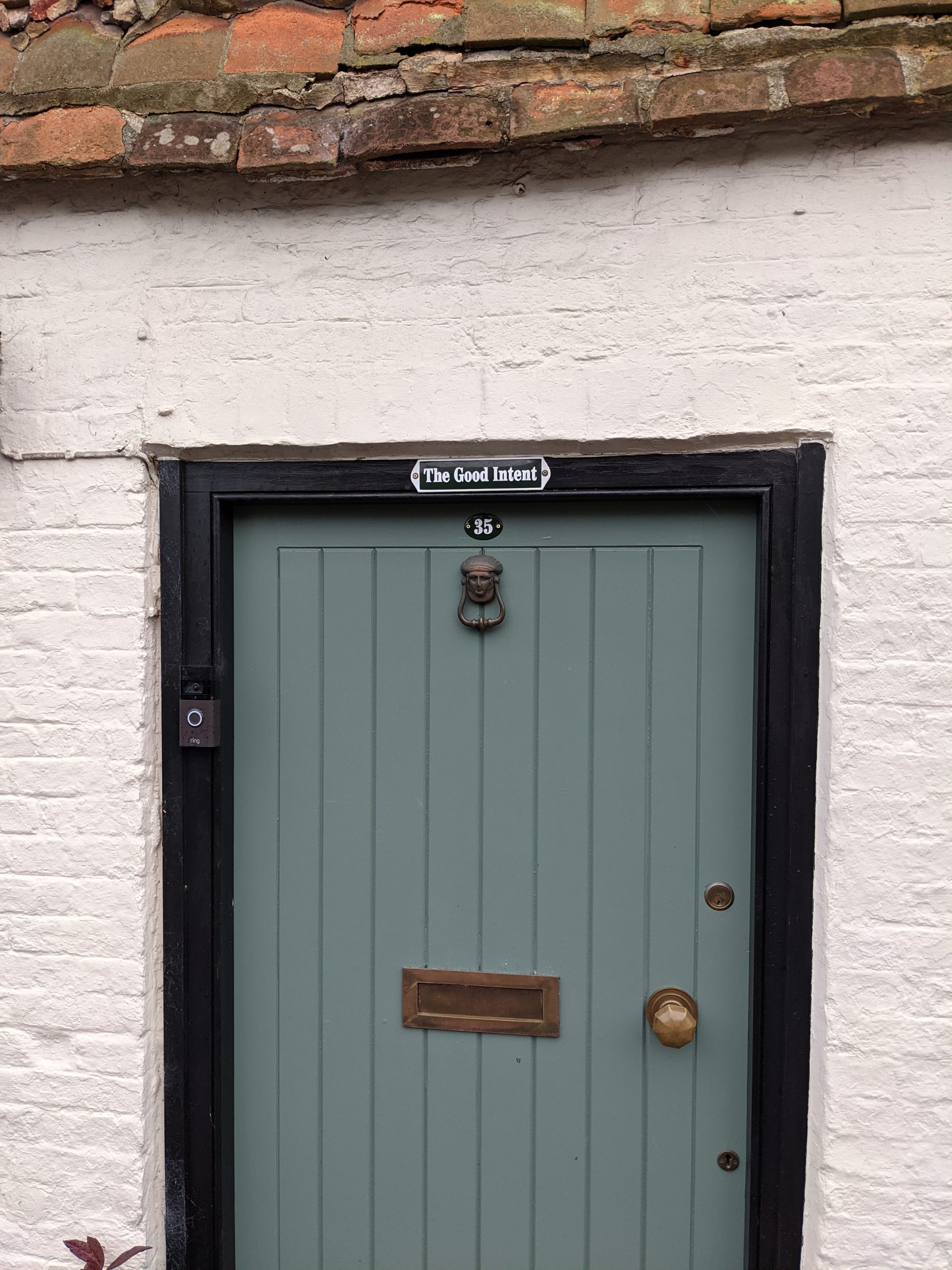
So, what has all this to do with the picture? Well it was the words “The Good Intent” above the door lintel that caught my eye as I walked past
I will explain…
Now, I happen to be a Church goer, and come across some fellow attenders (very genuine people) who treat homeopathy with great suspicion; possibly even a dark art.
You can guarantee, that any opinion goes no further than that; an opinion without much knowledge.
Still, to my mind, very strange.
The keyword is “Intent“. Otherwise put, what is one’s intention? In children’s Sunday clubs I have heard taught, “What would Jesus do?“, which rather hits the same mark.
It is our intention that is most important; in all things. And, I have to say from my experience of the many homeopaths that I have met, that their intentions are solely to help their clients to the best of their ability. And certainly not to engage in sorcerery!
Homeopathy does pose some interesting questions about who we humans really are. Are we just a bundle of molecules dancing in some sort of harmony? I touched on this subject before.
Our current understanding of the human body is remarkable tribute to modern science, but there are many mysteries still, and over time these mysteries tend to multiply rather than diminish. Who are we? What does it mean to be conscious, to be alive? These are big unanswered questions. Take a look at the work of the Galileo Commission here.
Complementary medicine in its various forms may not provide all the answers, yet its strength is in its recognition of both the material and non-material nature of man. This is the holistic perspective.
Returning to the matter of intention, a cursory recollection of recent news stories, will bring to mind plently of examples of bad intent. Sadly, all too often from within organisations that are held in high regard.
So, in short, I rather liked the name of the house in the picture.
Does it reflect the spirit of the owners, or is it two words to make those crossing the threshold pause for thought?
The Society of Homeopaths sets down clear requirements of its members in its Code of Ethics and Practice. Complaints upheld against practitioners are very rare.
Unfortunately, complaints of a vexatious and mischievous nature are significantly more common these days, often orchestrated by a small number of people whose world view is dominated by a rigid scientific materialist model (which roughly put says if you can’t see it it doesn’t exist).
They are entitled to their opinions of course. However, whilst constructive criticism can often be of good intent; destructive criticism rather suggests the opposite.
None are forced to try homeopathy, but it offers a different perspective on health which has proven to be of value for many.
Wishing you a good Christmas and good health. Next month, I will return to less combatative territory and consider homeopathy as first aid in the home.

Here are some ideas for self help with colds and flu. And little about homeopathy which can help too.
I caught a cold last week – in common with many others, it seems. Well, it is that time of year. Pre-pandemic, colds and flu were not newsworthy – but they are now. I shall not labour the point, but the media doom and gloom is not particularly helpful.
As we have all learned during these past months, respiratory infections are caused by viruses and viruses that tend to mutate.
The characteristics of the various offending bugs we can leave to the scientists, but when it comes to the counter attack, respiratory viruses seem to be rather slippery characters.
Fortunately most respiratory infections are self limiting – even Covid. Being sensible makes a significant difference to the outcome.
So what are the tips for self help with colds and flu? And what should we not do?
I just penned a short editorial for the The Herald (issue 414 p38). What could be said in 300 words is limited, but I emphasised the importance of good general health in building immunity.
Modern life with its cities and technologies is about as distant from the natural world as you can get. One of the gains from the environmental movement is a reawakening to that lost connection.
Here are three simple steps to reconnect:
Firstly, get a good night’s sleep. As the hours of daylight shorten, you don’t need to be a genius to infer that this is suggestive of more sleep. Sleep is a health regenerating process and a lack of sleep increases our vulnerability to infection.
Secondly, consider your eating habits. Eating may be pleasurable, but its real purpose is to supply the body with the necessary nutrients. The gut flora is known to be important in immune health. It is common sense then to focus on healthy fresh food.
Thirdly, get outside into the sunlight as much as you can. Living by the New Forest and the coast, there are plenty of options. Not only is exercise good for the body, it is good for the mind also.
Whilst nutrition should be the main source of vitamins and minerals, there is a logic to vitamin D (specifically vitamin D3) supplementation during the winter months.
Otherwise known as the sunshine vitamin, it is made by the action of sunlight on the skin. Reduced daylight and overcast weather mean that vitamin D deficiency is common in winter.
Vitamin D has many functions which you can look up online, but of particular relevance is its role in maintaining respiratory health. It is generally anti-inflammatory.
Daily supplementation in the range of 2000 to 4000 IU (international units) or 50 to 100 micrograms should be perfectly safe for adults (half the dose for under 12s).
Start low and increase as winter progresses, then tail off again as the days lengthen. As ever, take advice if you have particular health conditions.
Theoretically excess vitamin D can be toxic (elevated calcium levels and intestinal symptoms) but such events require massive doses over extended periods. In short, sensible supplementation is safe.
The supplement is mostly available as tablets or capsule of 1000 to 2000 IU tablets which is itself a guide to dosage.
You may recall a time when Mums gave cod-liver oil to her school age kids? Guess what, it is Vitamin D rich. Two teaspoons is about 1000IU
Here is a selection of articles / videos. The NHS dosage guidelines (just 400IU) seem to be rather conservative.
NHS Vitamin D Healthline Vitamin D Dr Seheult Medcram John Campbell PhD Epidemic Influenza and Vitamin D
We all do, and it may even be necessary that we do so in order to keep the immune system in trim. Or it could be a reminder to slow down, and metaphorically ‘recharge the batteries’.
So, here are the tips for self-help with cold and flu. What should you do? Or not to do?
In short:
When we get a cold it is popular to reach for over the counter medicines most of which contain Paracetamol or aspirin (pain / fever relief), and other ingredients like Pseudoephedrine (decongestant) that relieve your symptoms.
Strange as it may seem, your symptoms are your body’s curative reaction to the virus. Unpleasant, these may be, but they have a purpose. Fever, for example, stimulates the immune system into action.
Here is a short quote from Dr Russell Malcolm a medical doctor and homeopath in Scotland:
“avoid Paracetamol and Aspirin completely …. [they] have no curative power at all … there is evidence that interfering with this process can lengthen the illness and increase the incidence of complications.”
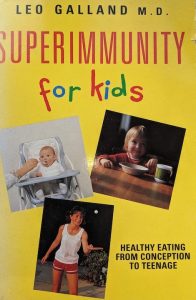
On my bookshelf is a small volume that I bought when my son was a baby 30 years back – in the chapter on respiratory infections, sore throats, colds and flu the author (American, Dr Leo Galland MD), puts it simply:
“I recommend rest, chicken soup and TLC (tender loving care). For severe infections with fever, lots of aches and/or uncomfortable congestion, I find short megadose therapy of vitamin C helpful.“
I’ll come back to vitamin C shortly.
Dr Malcolm also states “Flu is not a headcold”. As the old joke says, if a £50 note blows into the garden when you have a headcold, you’ll wrap-up and go out to catch it, with flu you surely will not!
Half a century earlier, Dr Dorothy Shepherd (1888-1952) said this:
“It is the fashion to call every slight feverish chill influenza; but if after the temperature has come down, the depression, exhaustion and weariness is such that it is too much effort to do anything, that life is really not worth living, you know you will have had influenza; after a mere feverish chill you will feel as well on getting up as you did before the attack.
Unfortunately many people take no notice of the danger signals of weakness and prostration, and insist on getting up, even returning to work before they are fit, thus laying themselves open to broncho-pneumonia…and sudden death’
‘During the feverish period the patient should be allowed nothing but raw fruit and fruit juices, and not synthetic bottled juices. Fresh oranges, lemon juice, apple drinks, grapefruit drinks at frequent intervals will cleans the system and prevent any undue strain being thrown on the gastric organs. No meat juices, no milk, are permissible. After the temperature is down, the diet may be increased and may include vegetable broth, Yeastrel drinks ( Marmite?), wholemeal toast. Gradually other foods may be added…“
No.1 rule then is REST. You may recall what happened to PM Boris Johnson when he tried to keep going through his Covid infection … viruses don’t respecter rank!
Modern society tends not to permit absence from work or school, which is a pity and probably counter productive …Covid, might remind us of old wisdom.
Vitamin C has a direct anti-viral effect that has been well researched.
Dr Leo Galland mentioned above, continued:

“To treat severe colds, viral infection such as sore throats or bronchitis, and flu, I find megadoses of vitamin C very effective…I recommend the highest dose you [or your child] can take. 1000mg an hour, until he begins to get loose bowels (Excess vitamin C…draws water into the intestines). This will establish [the] saturation point.
Stop the vitamin C until the next day, when you [or your child] should [take] 1000mg every 2-3 hours until the bowels become loose. Stop the vitamins again until the third day, when you should give 1000mg every four to six hours. Maintain this dose until the cold is over, then gradually cut the dose back over two weeks to 1000mg a day.
The anti-viral effect of vitamin C depends on getting the highest level possible into the tissues.
Is it safe? Very: not only against viruses but also acute allergic reactions. When should you not give vitamin C? If you [your child] has kidney disease or is too sick to take food and liquid along with it.“
This is the protocol I follow myself. Loose bowels do not result in my case, but they may for you, everyone is different.
Zinc has a important function in supporting immune health. A healthy diet should suffice for daily needs, but supplemention at 20-40mg per day when you are sick can be helpful.
The herbal remedy Echinacea can also help on first signs of a cold or flu. But Echinacea should be taken for only a few days (say a week) as thereafter it can be counter productive. Follow the manufacturers guidance on dosage.
Most respiratory infections are self limiting and are more likely to be so, if you follow the good advice above. Homeopathic medicine can undoubtably speed recovery but selection of the correct remedy takes a little skill, but can be learned. First aid kits are available for home use.
Should you have a viral respiratory illness that is lingering on uncomfortably, and wish to try a homeopathic approach please call and leave a message or text (see Contact) and I will call back – the ‘Discovery Call’ arrangement is for clients with longer term issues. (Expect a nominal charge of around £10 for any remedy sent).
However – and very importantly – seek immediate medical help (GP or A&E) if your condition is getting worse and especially if you have breathing difficulties.